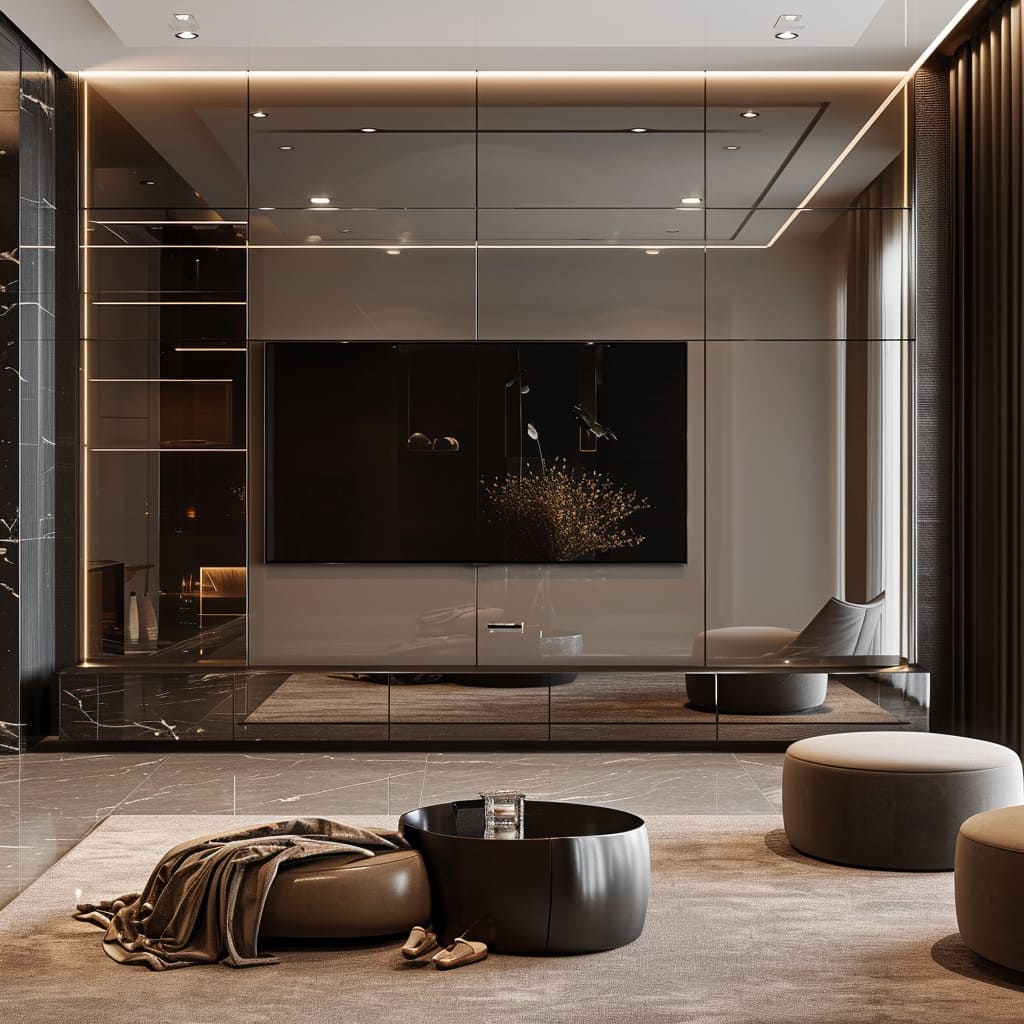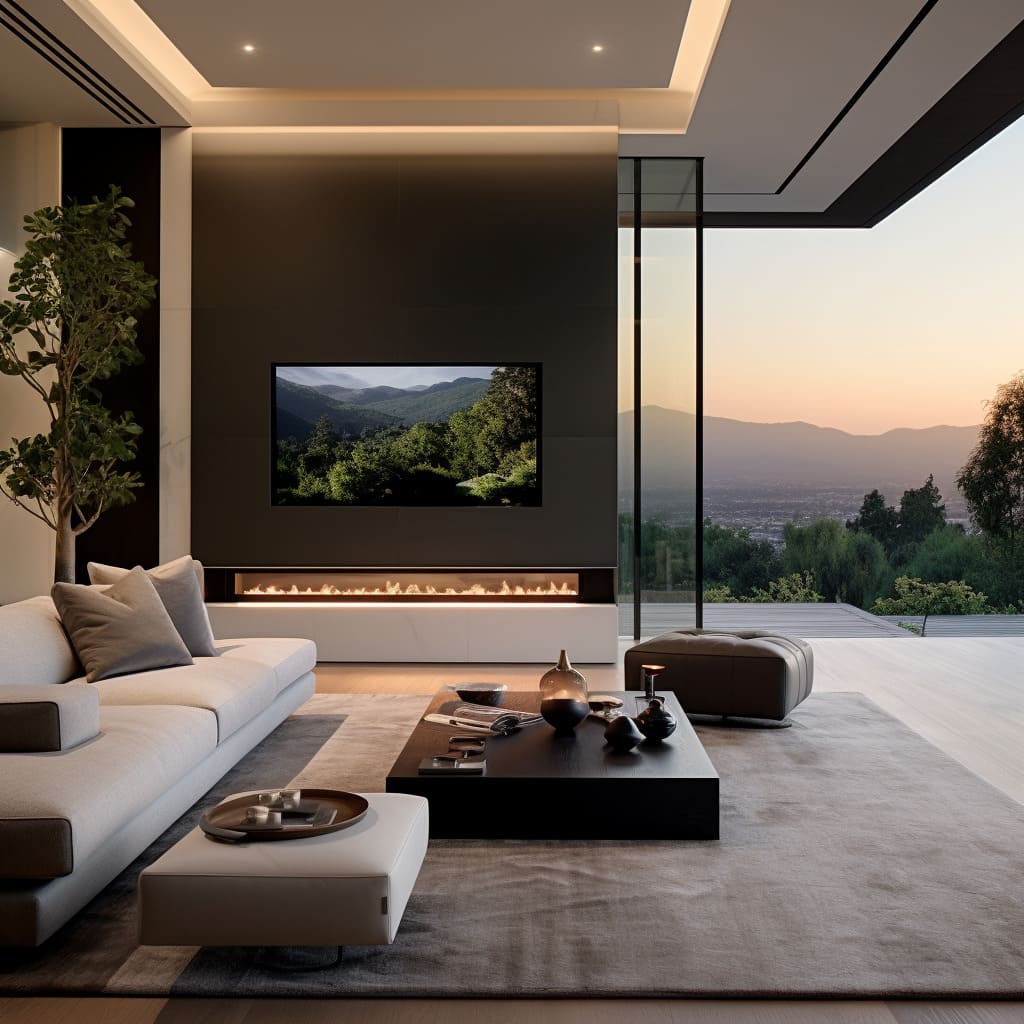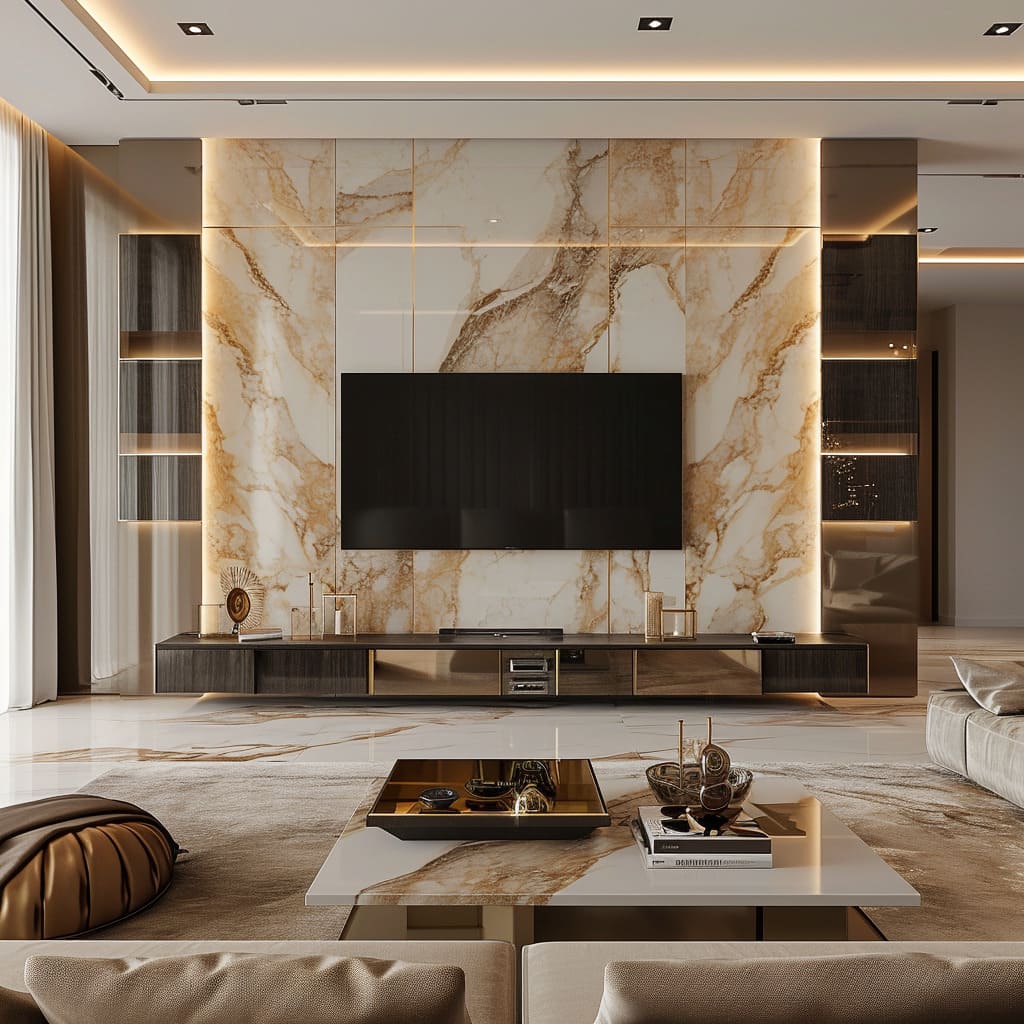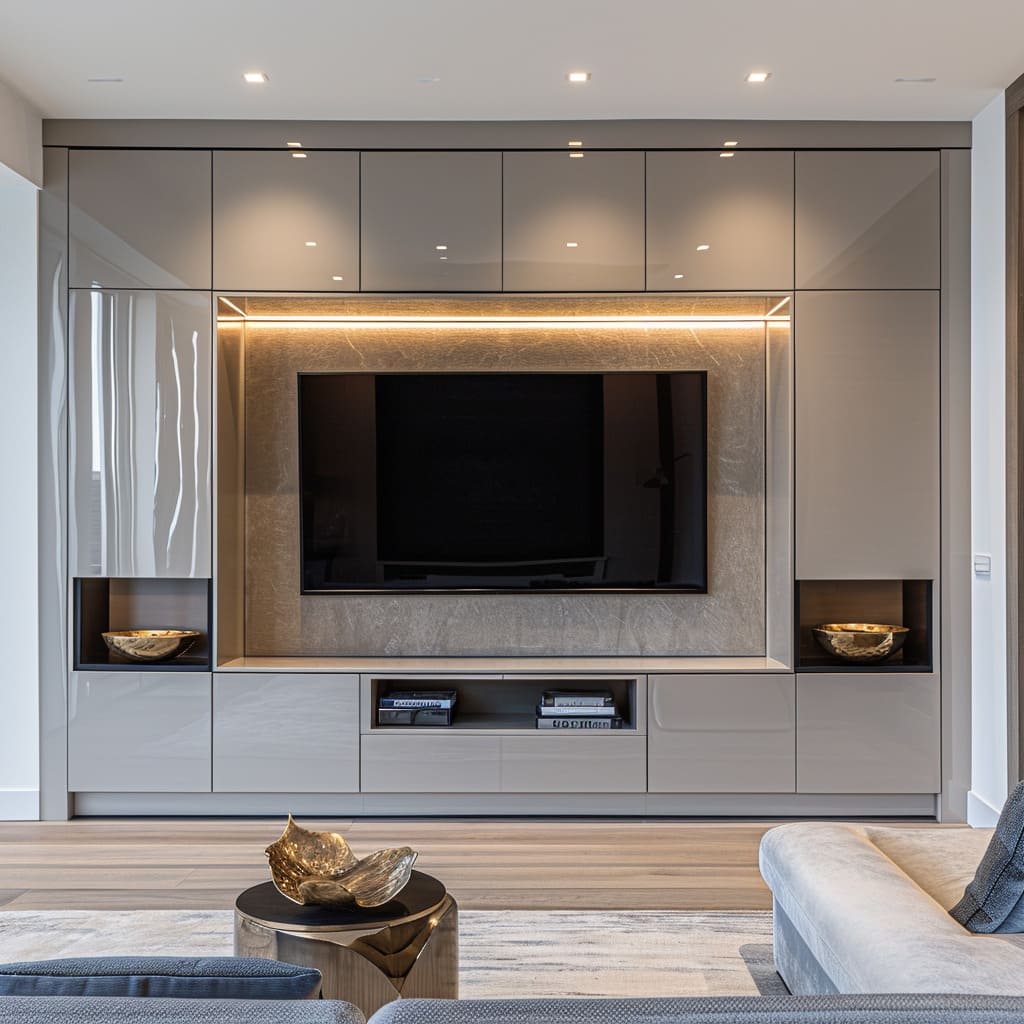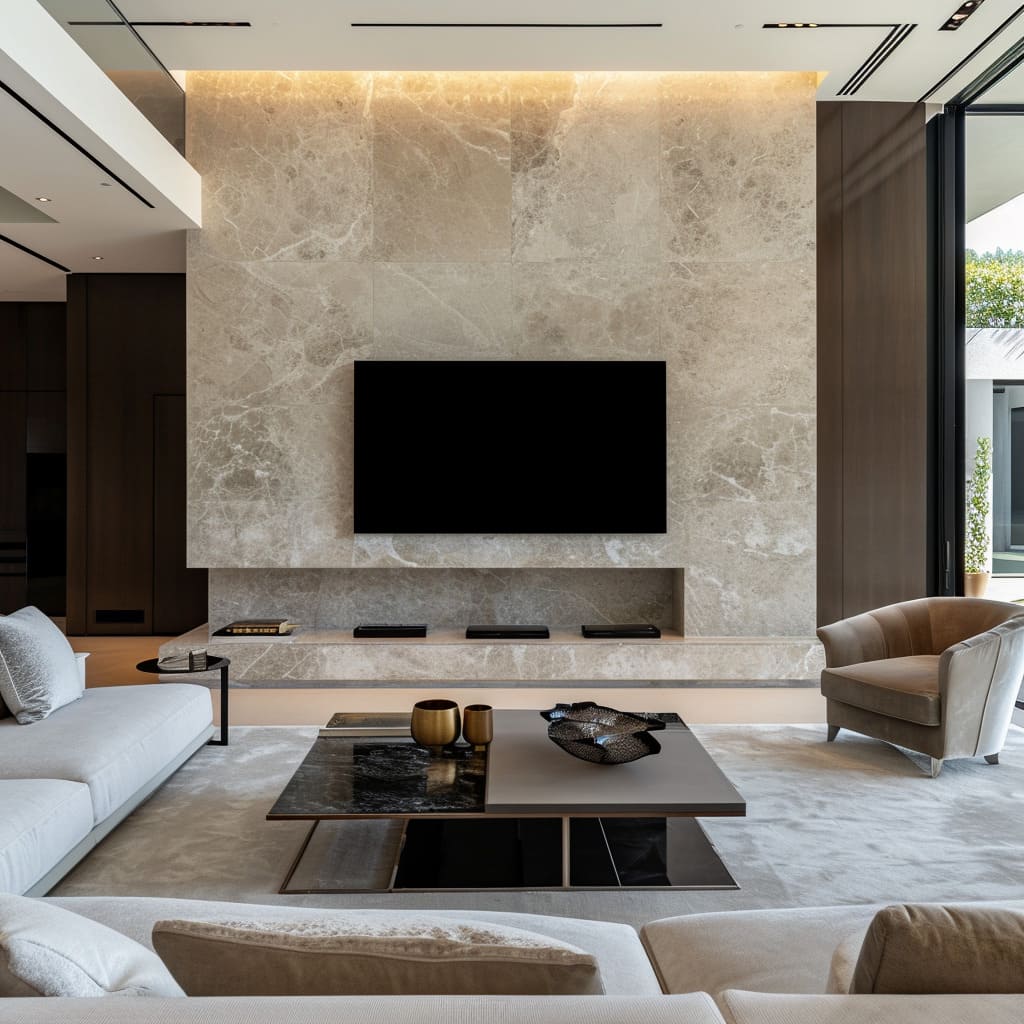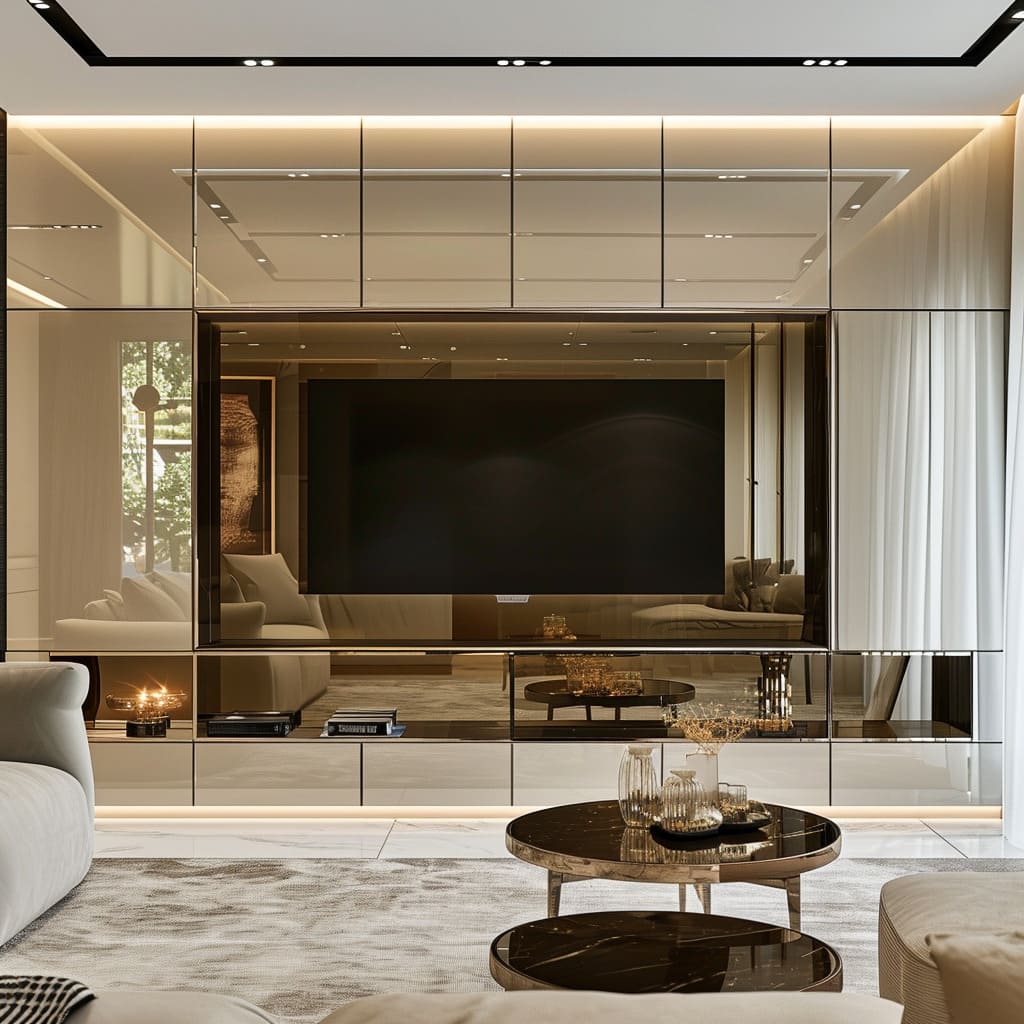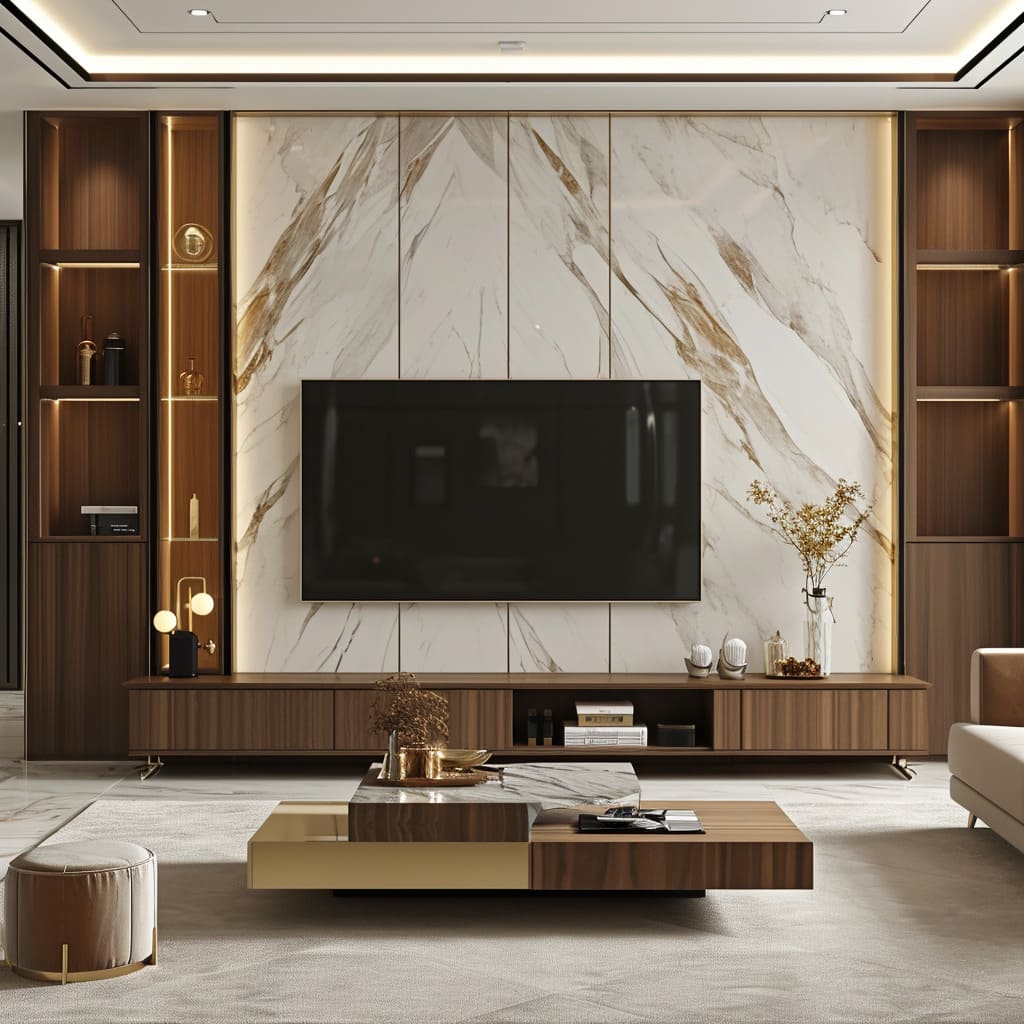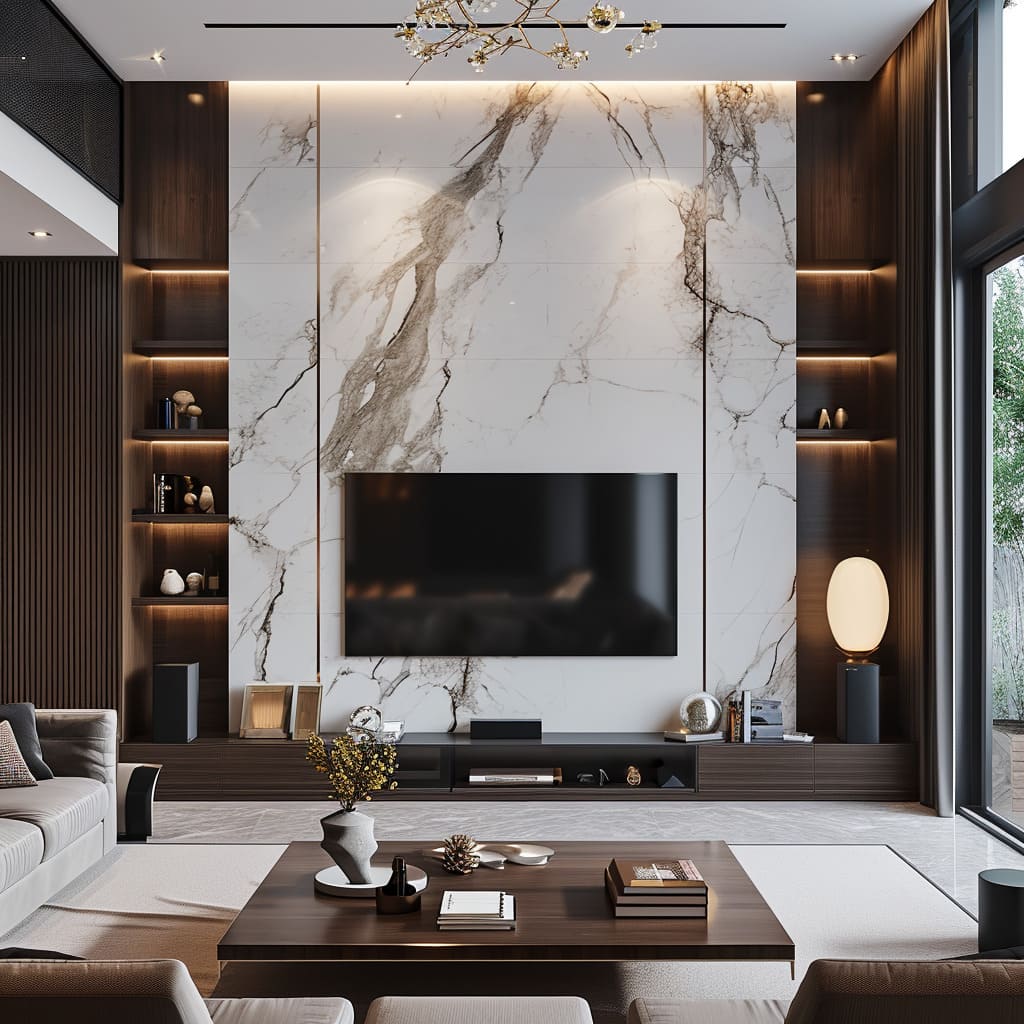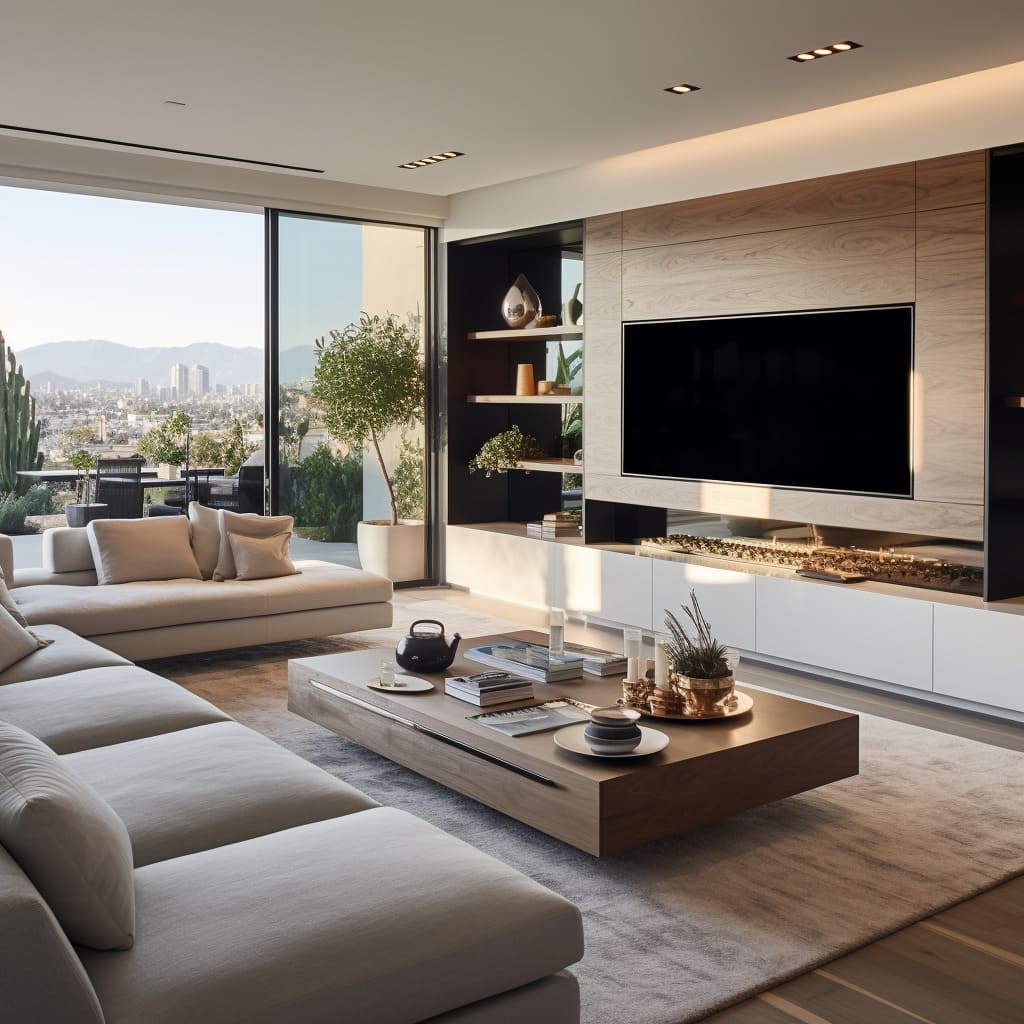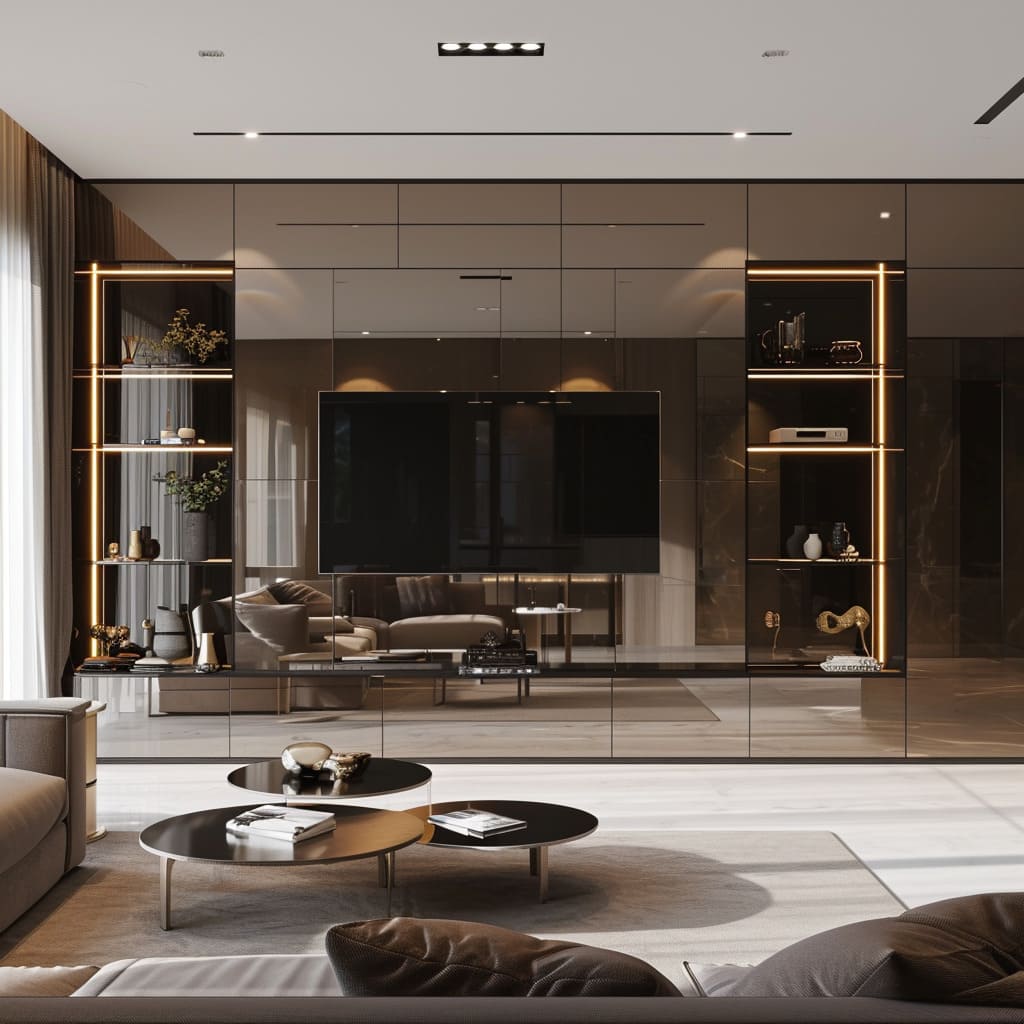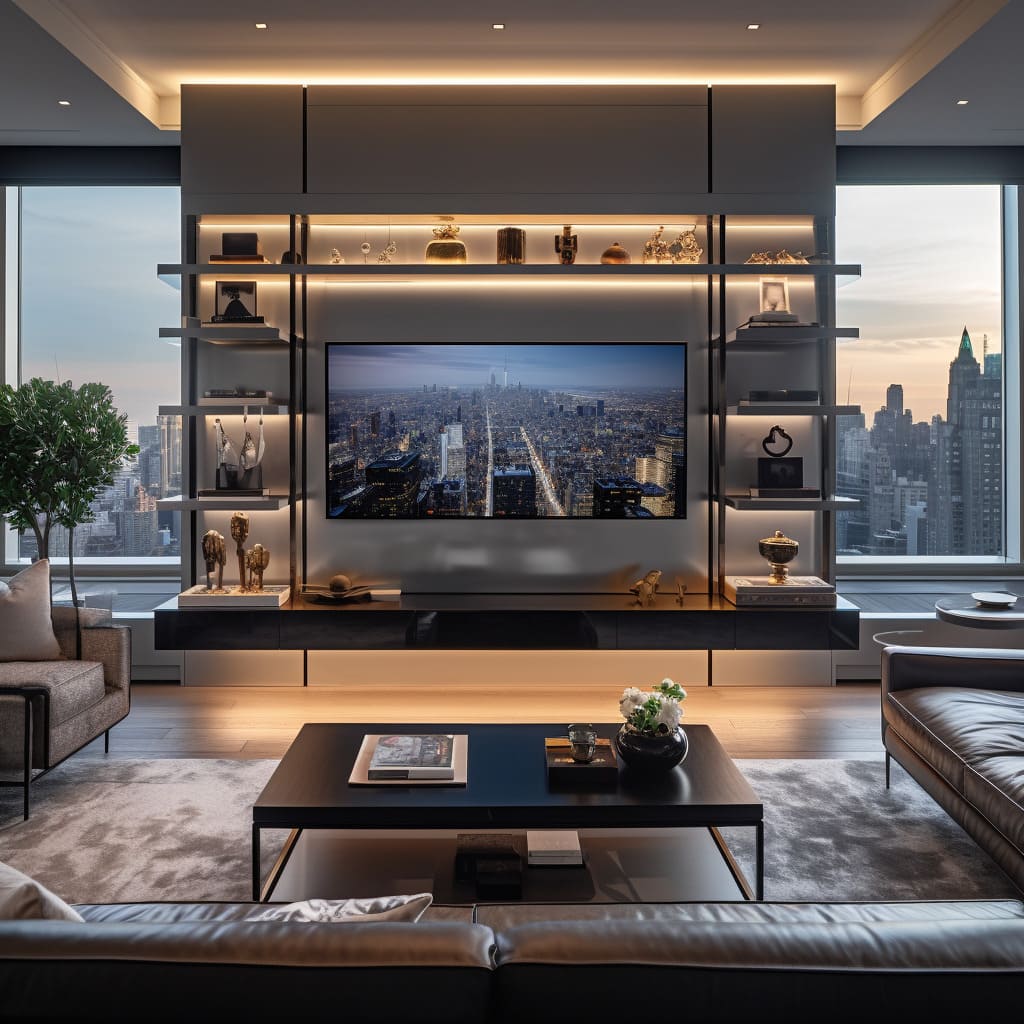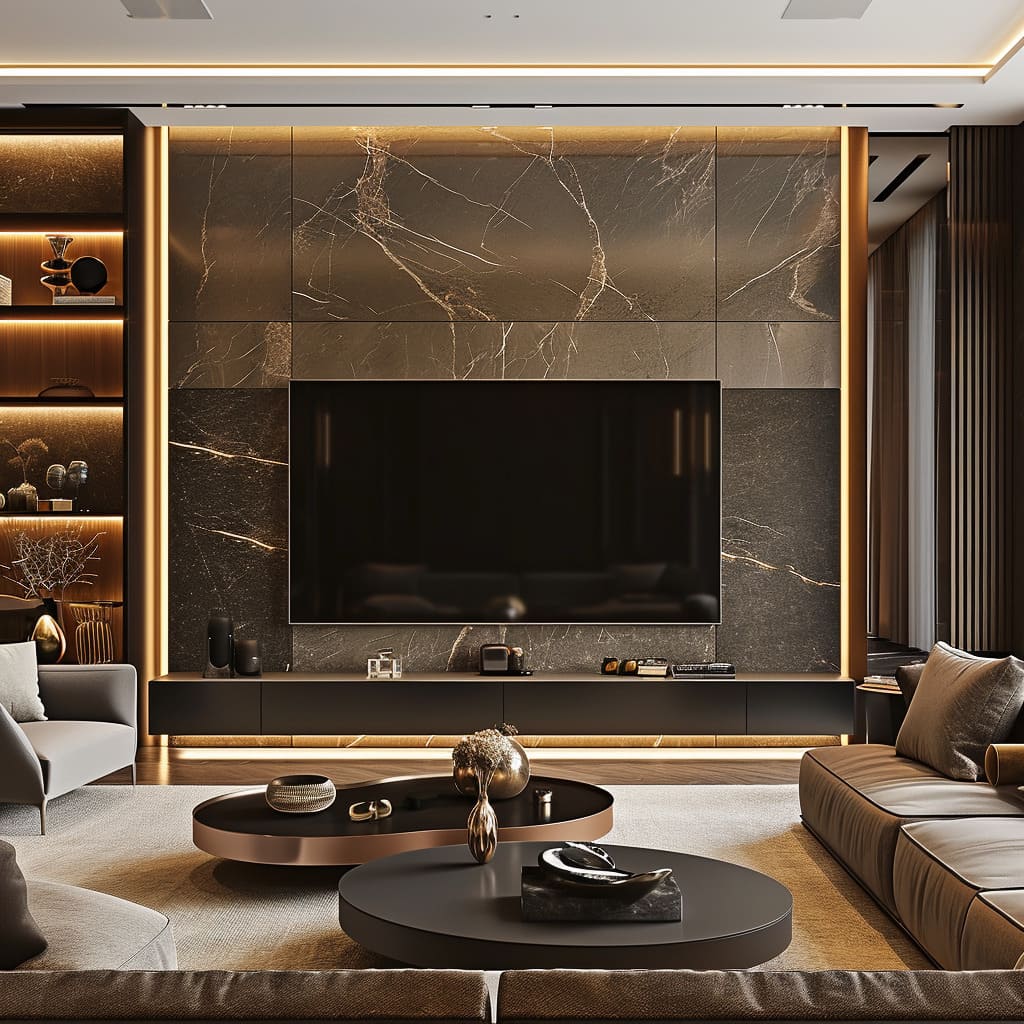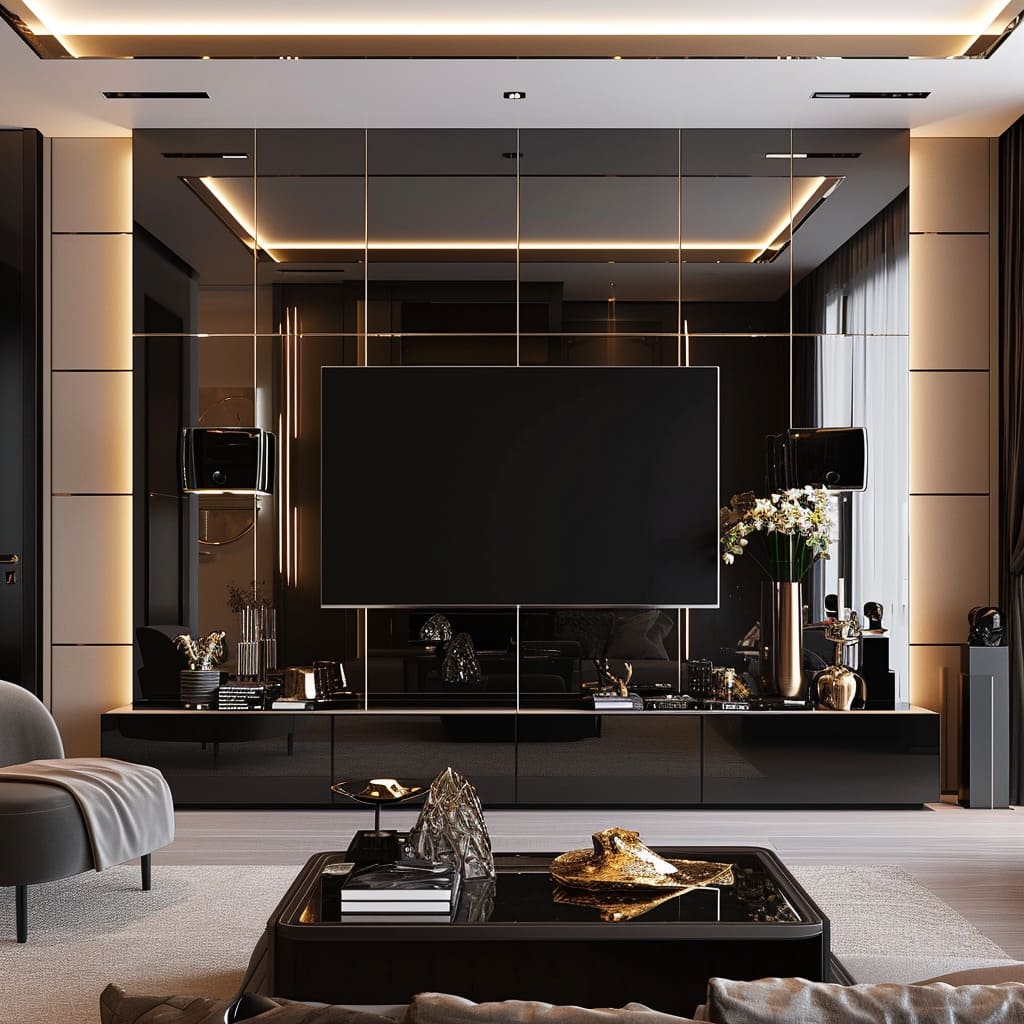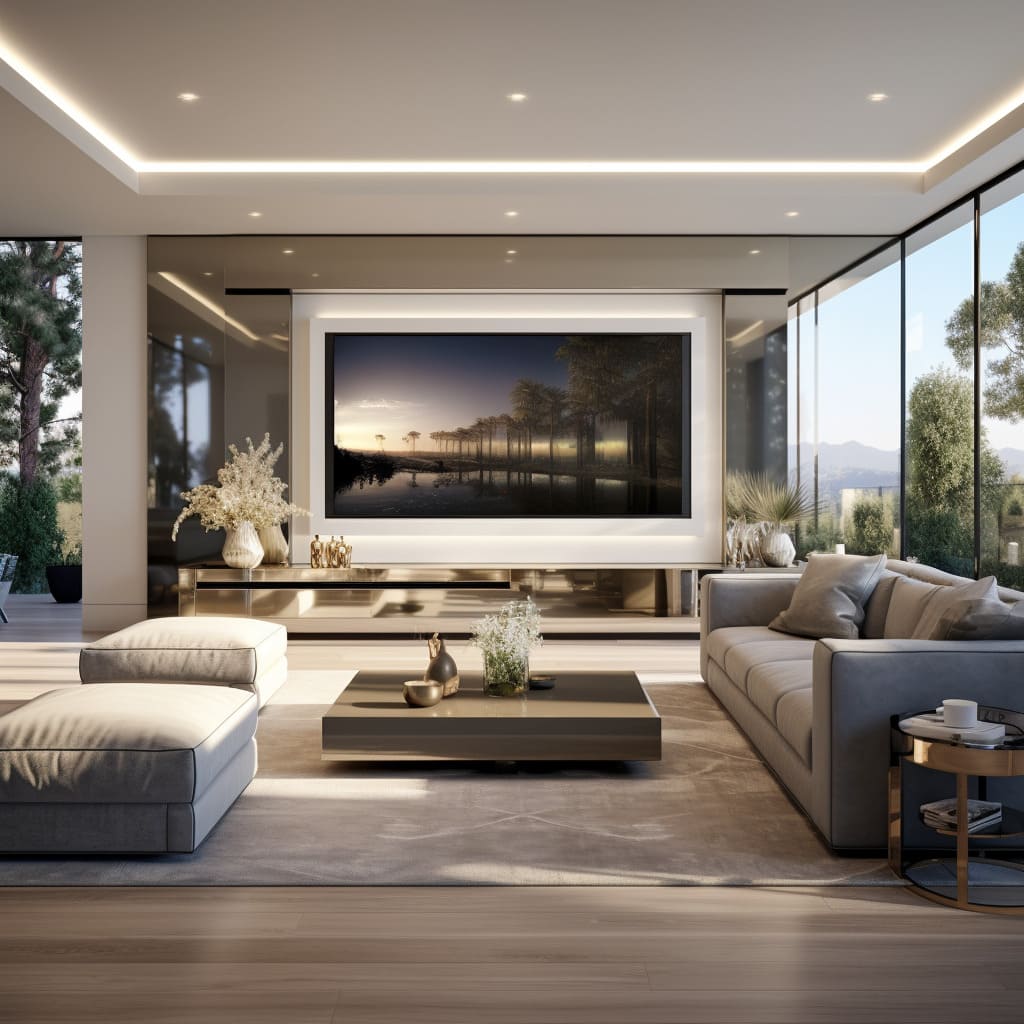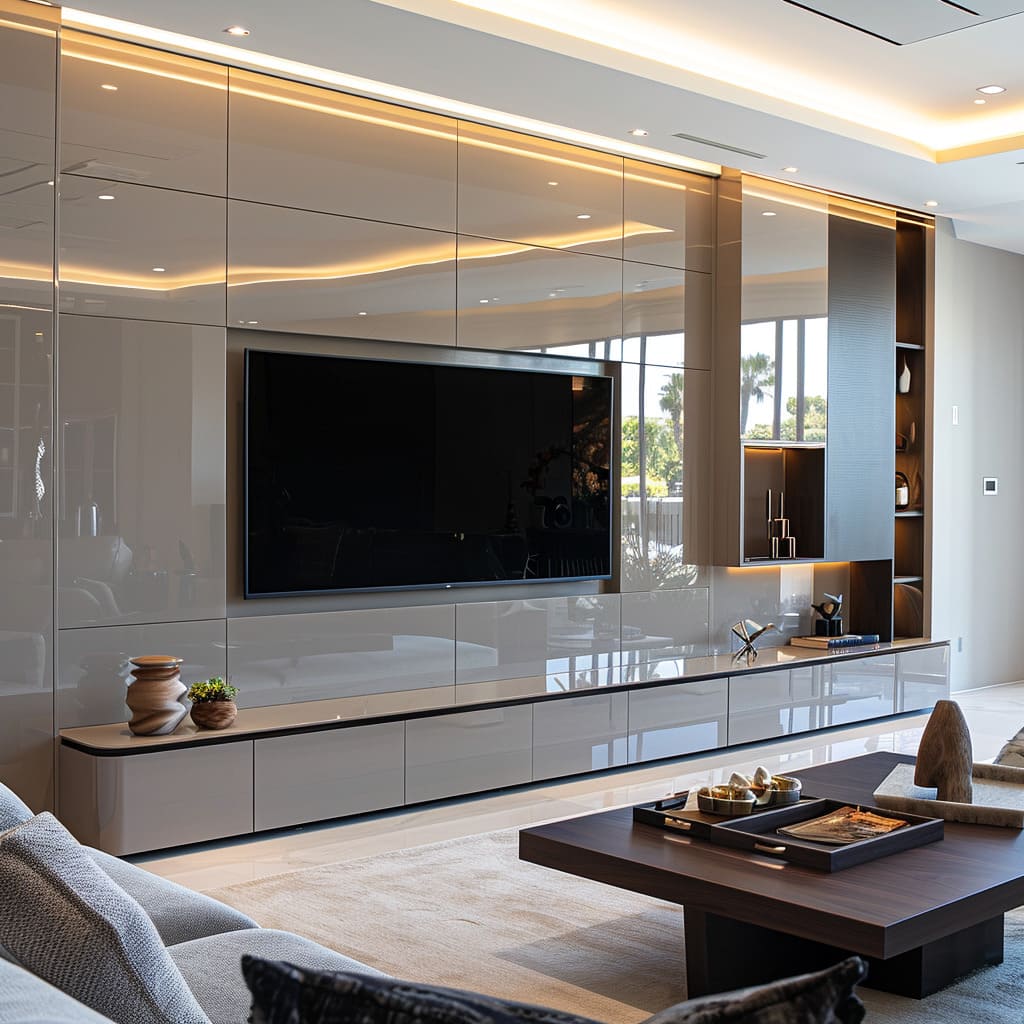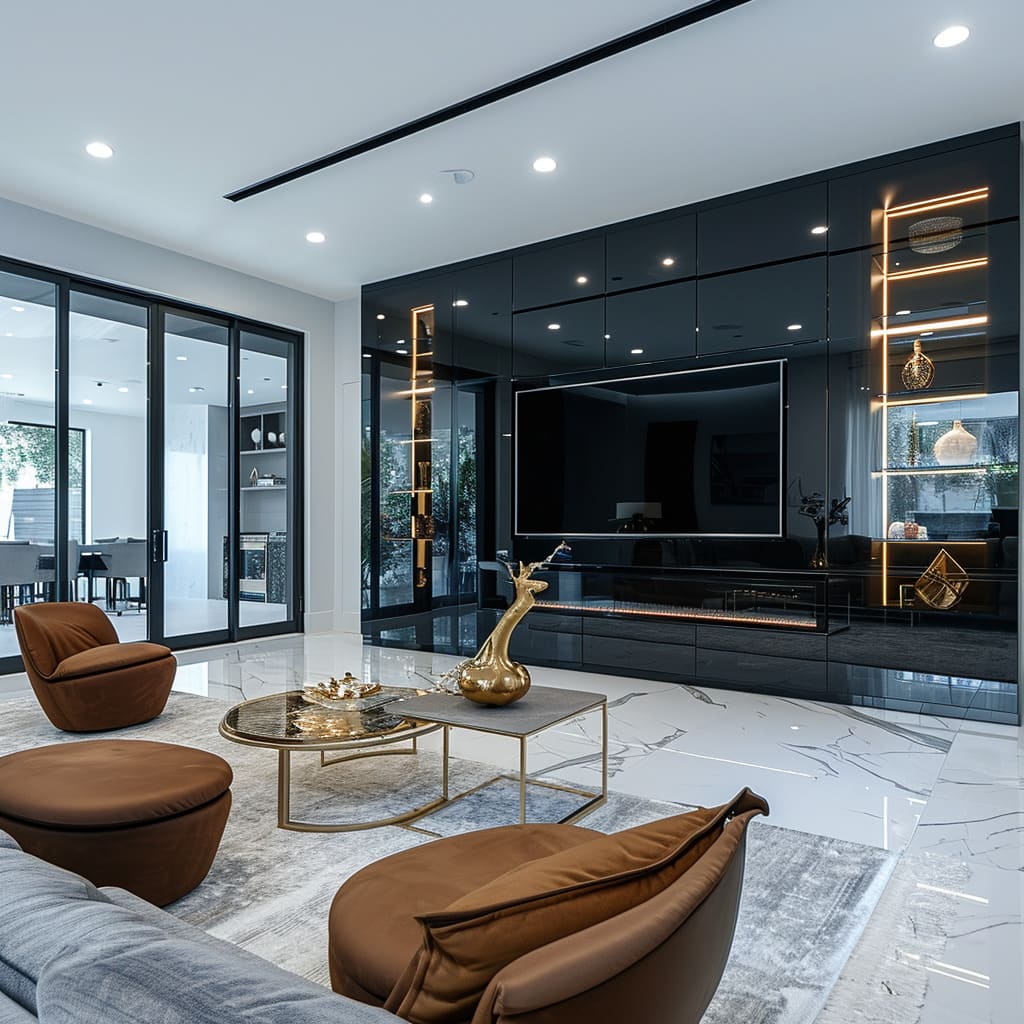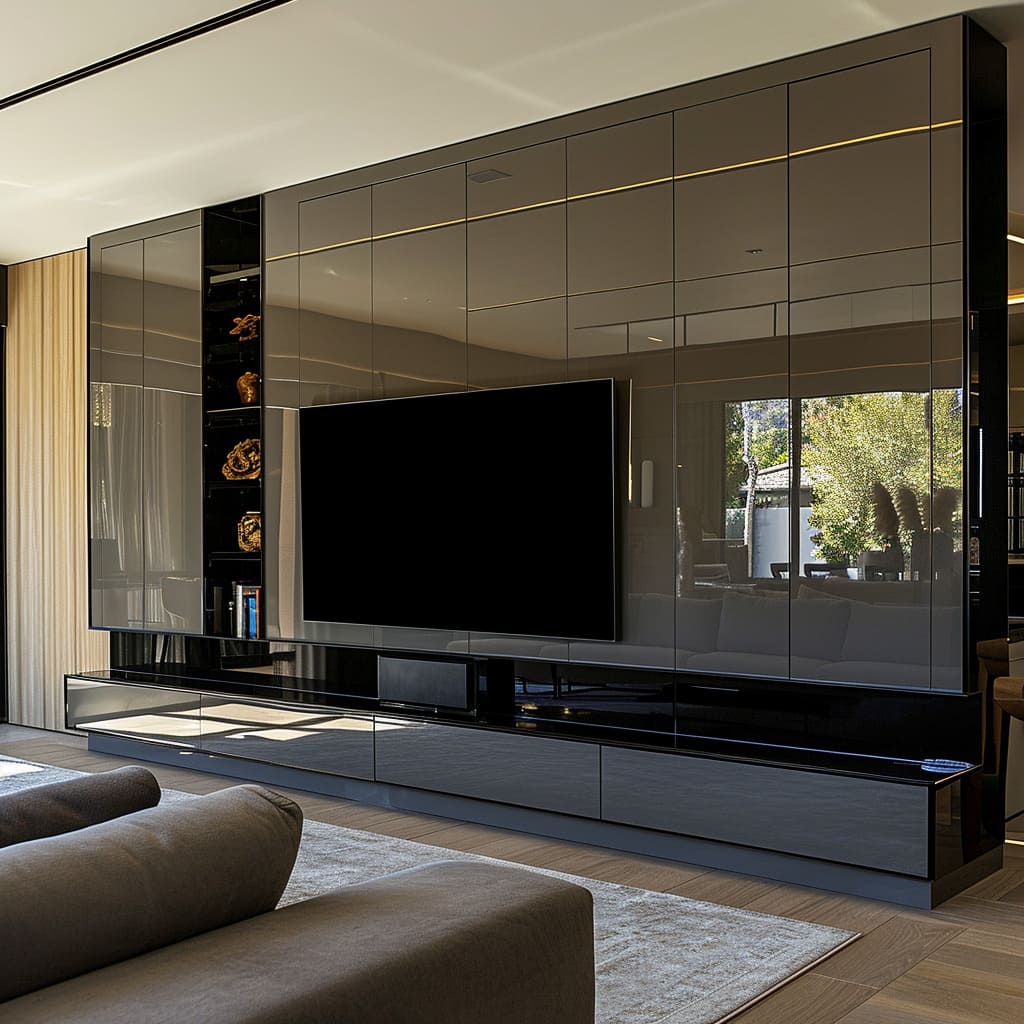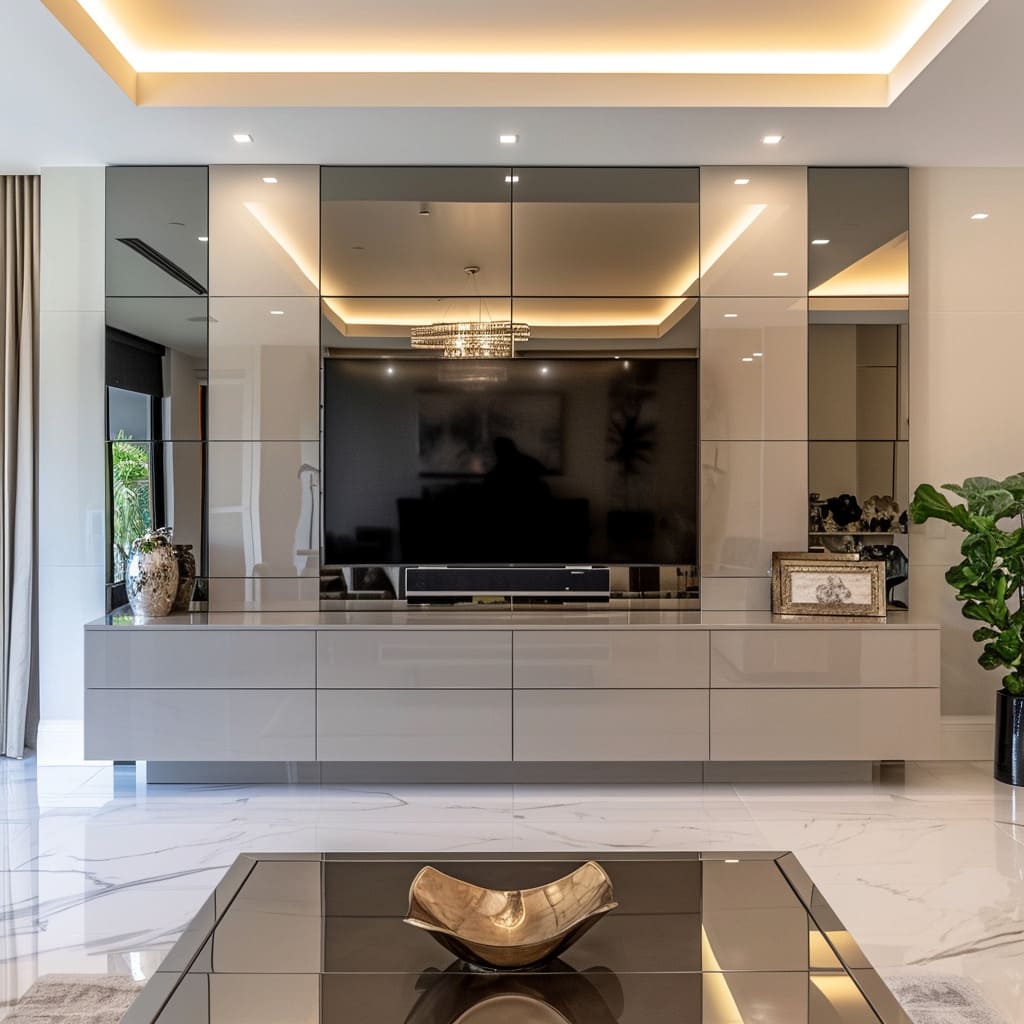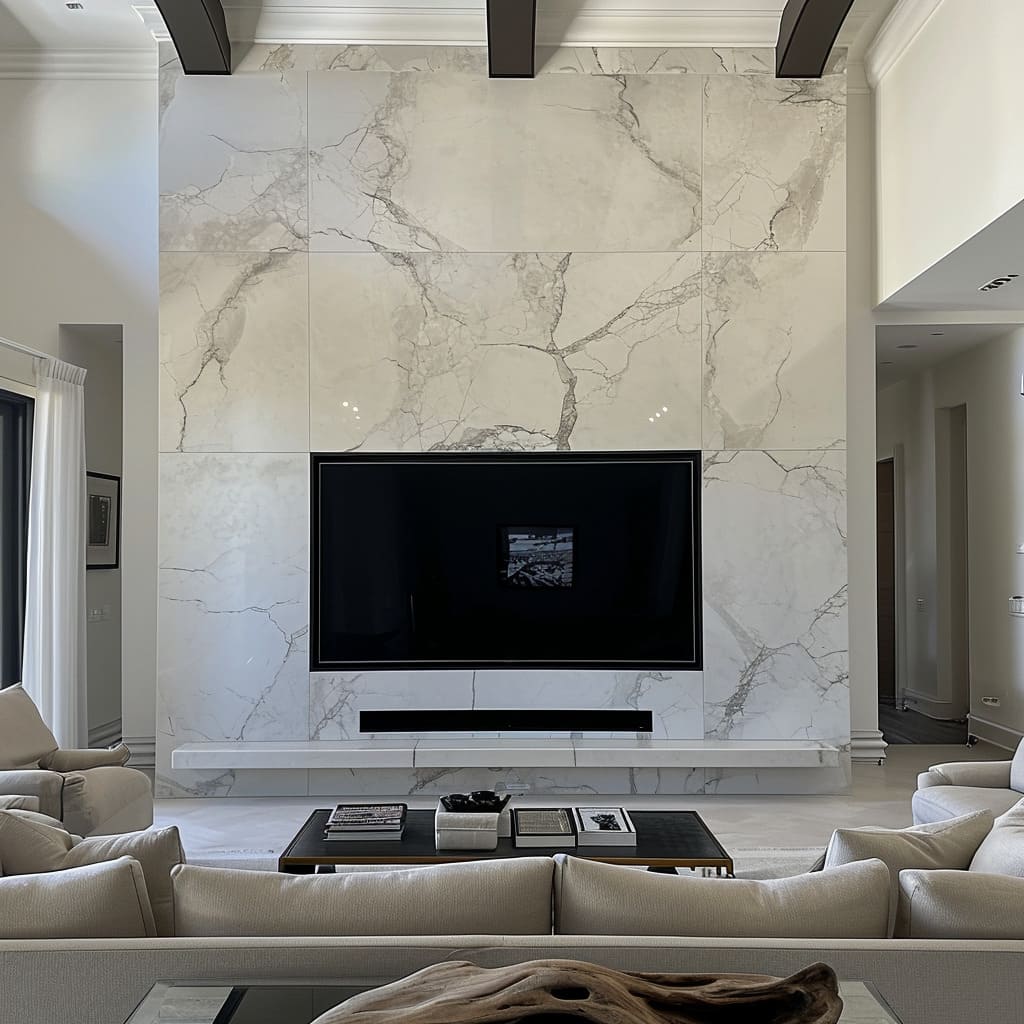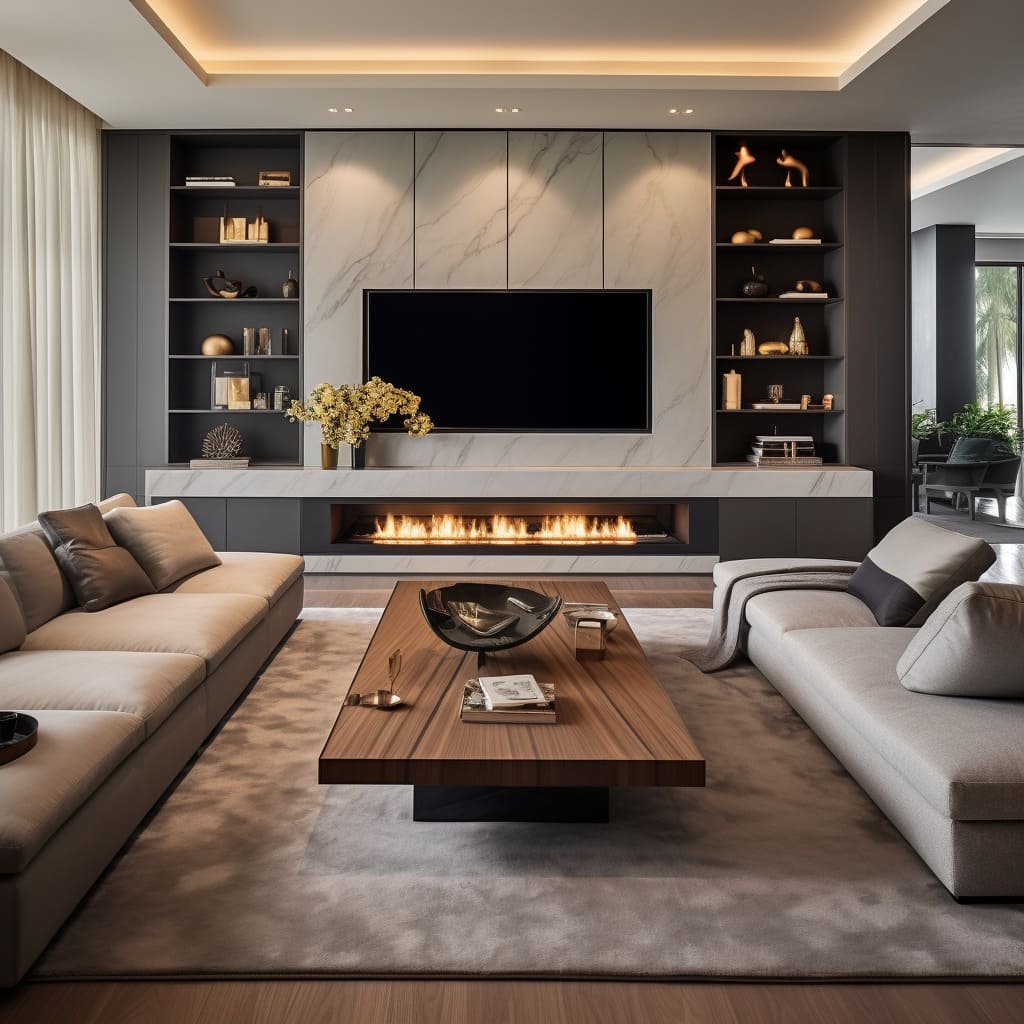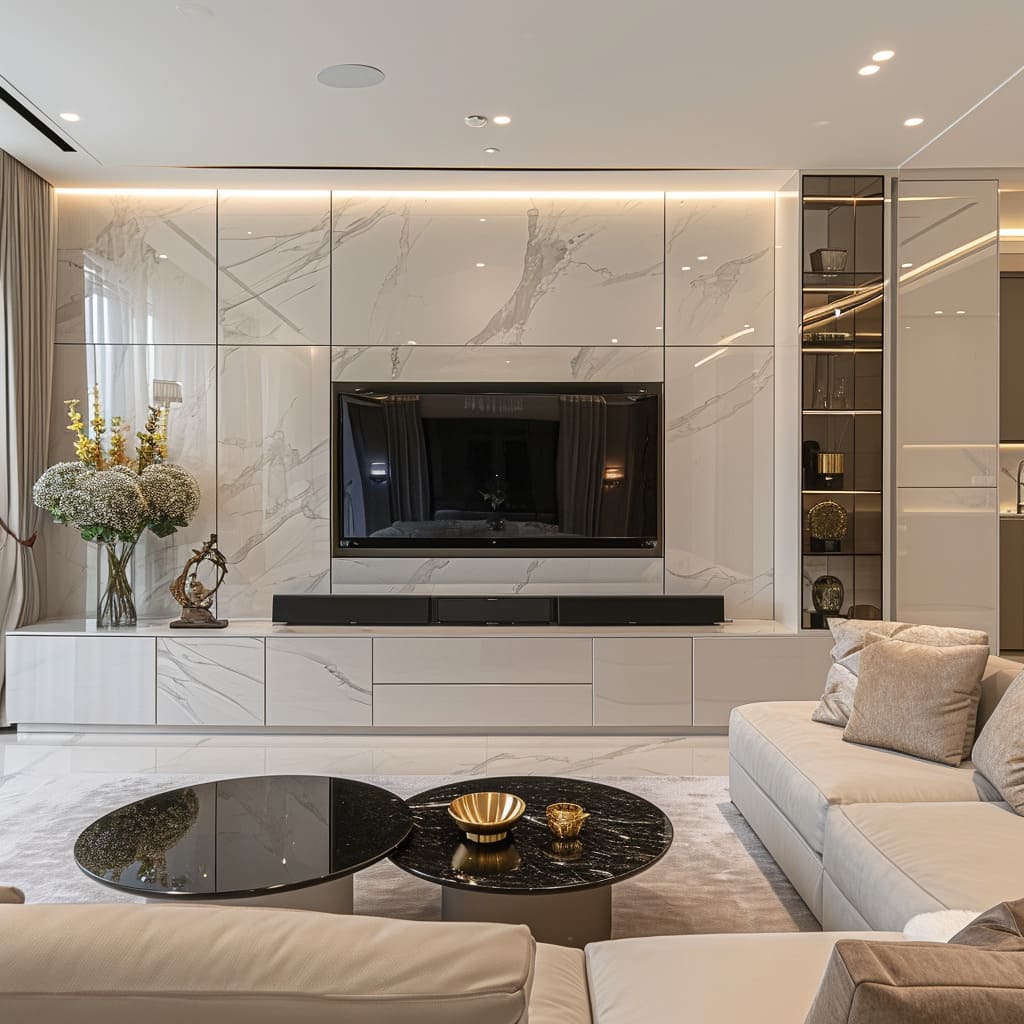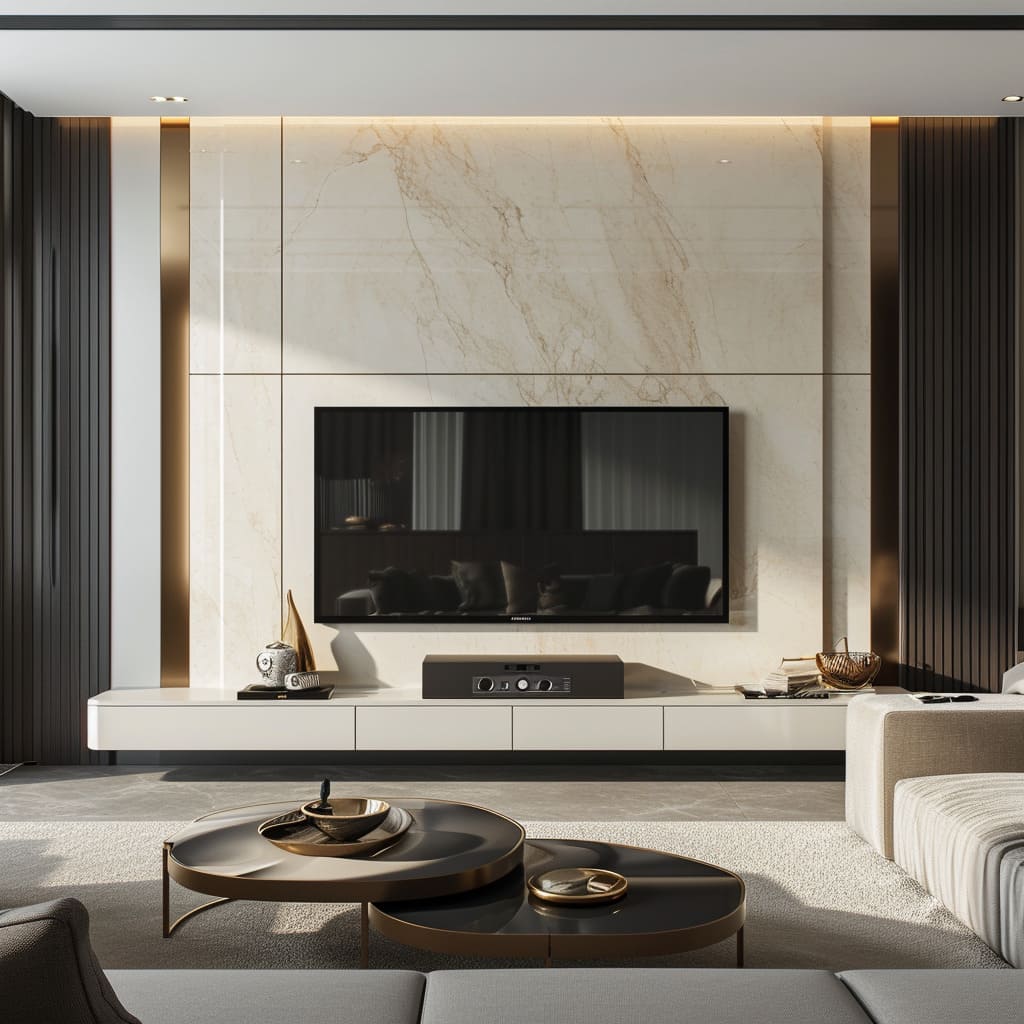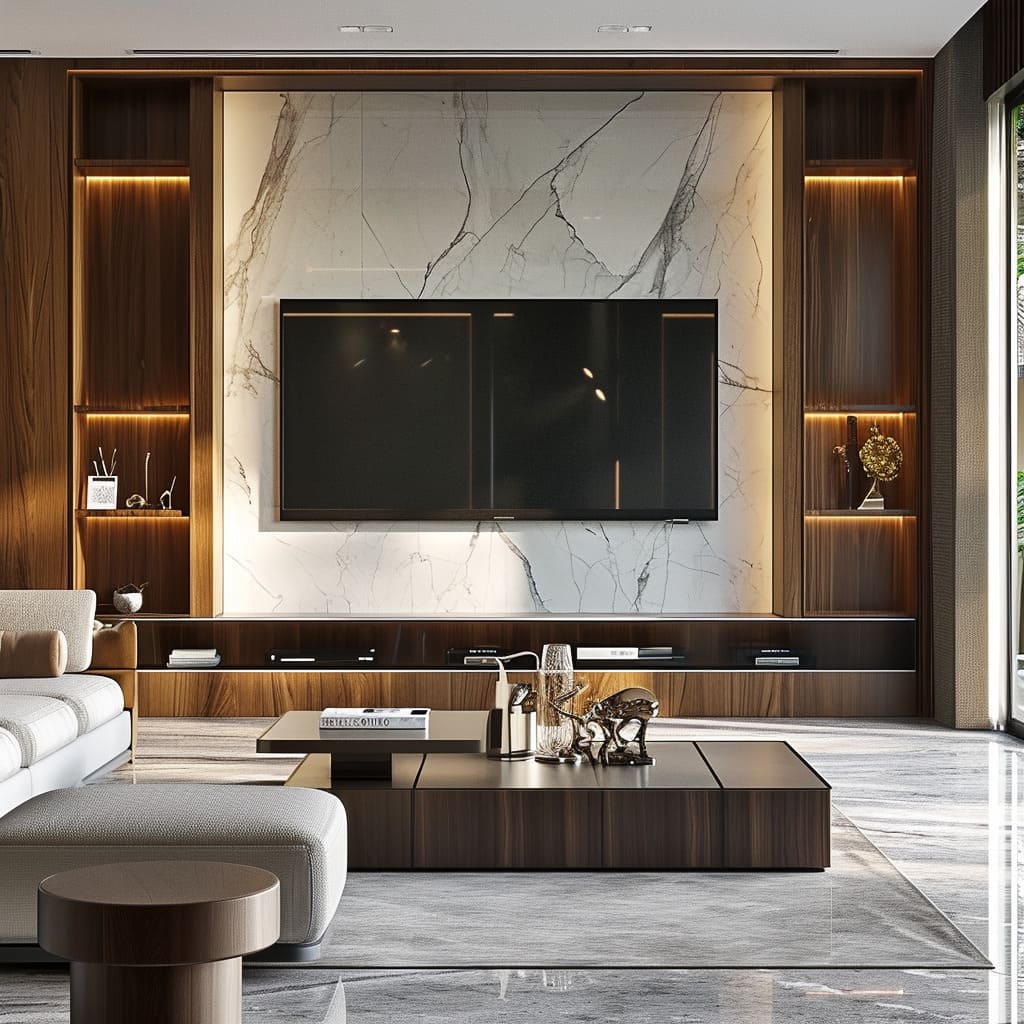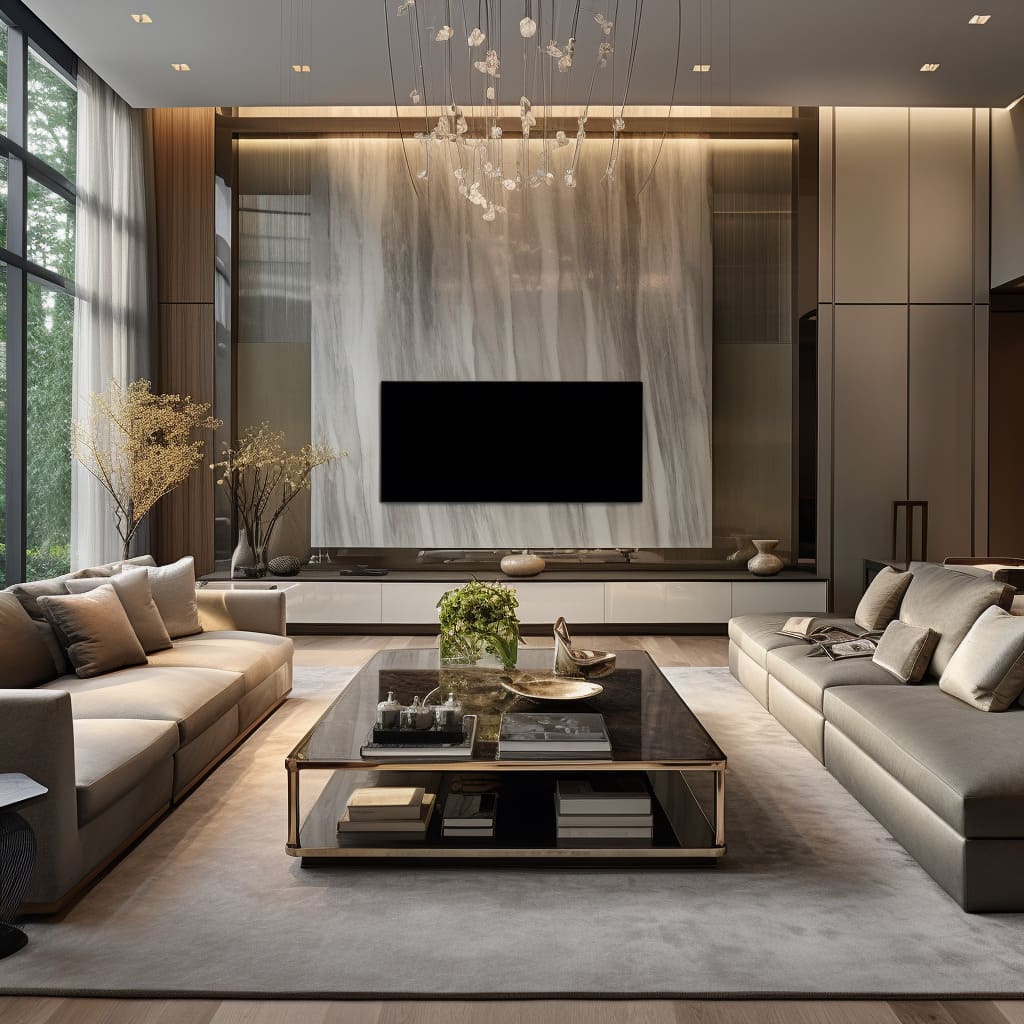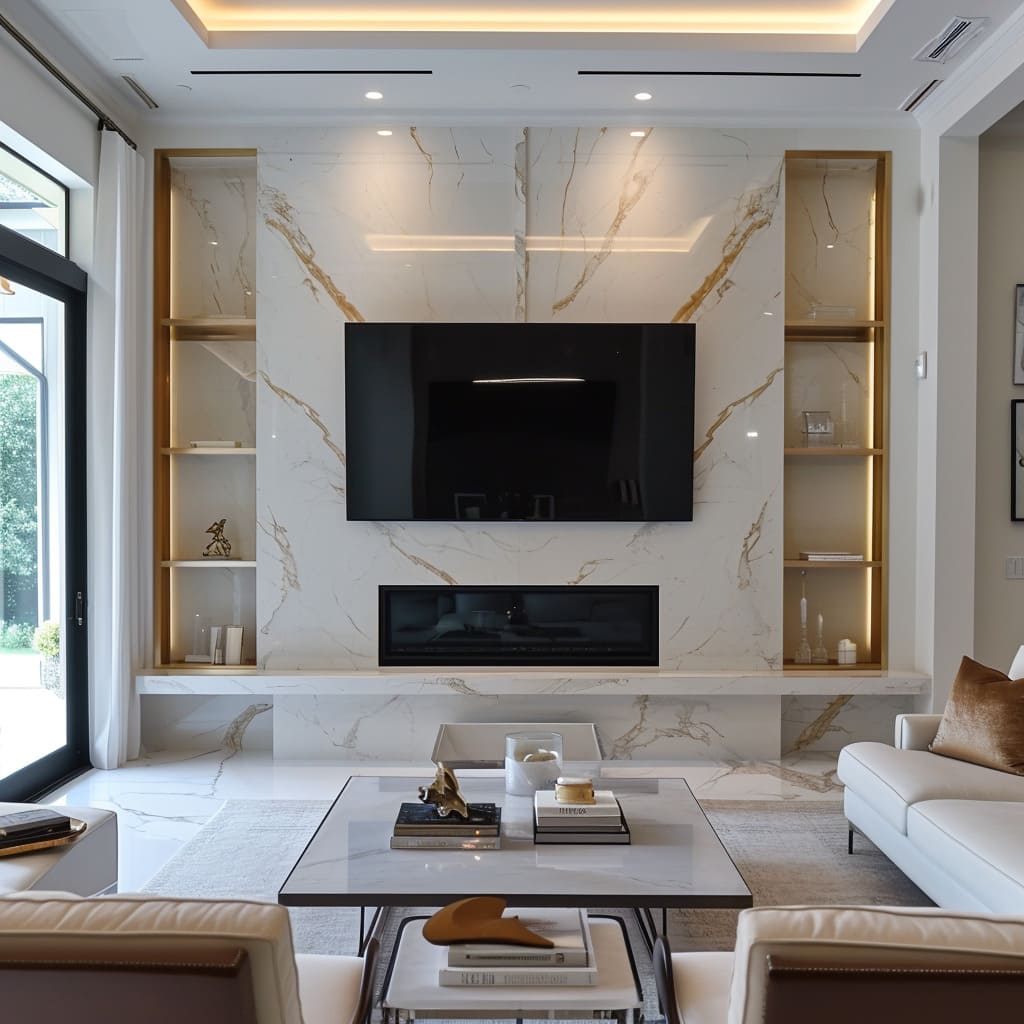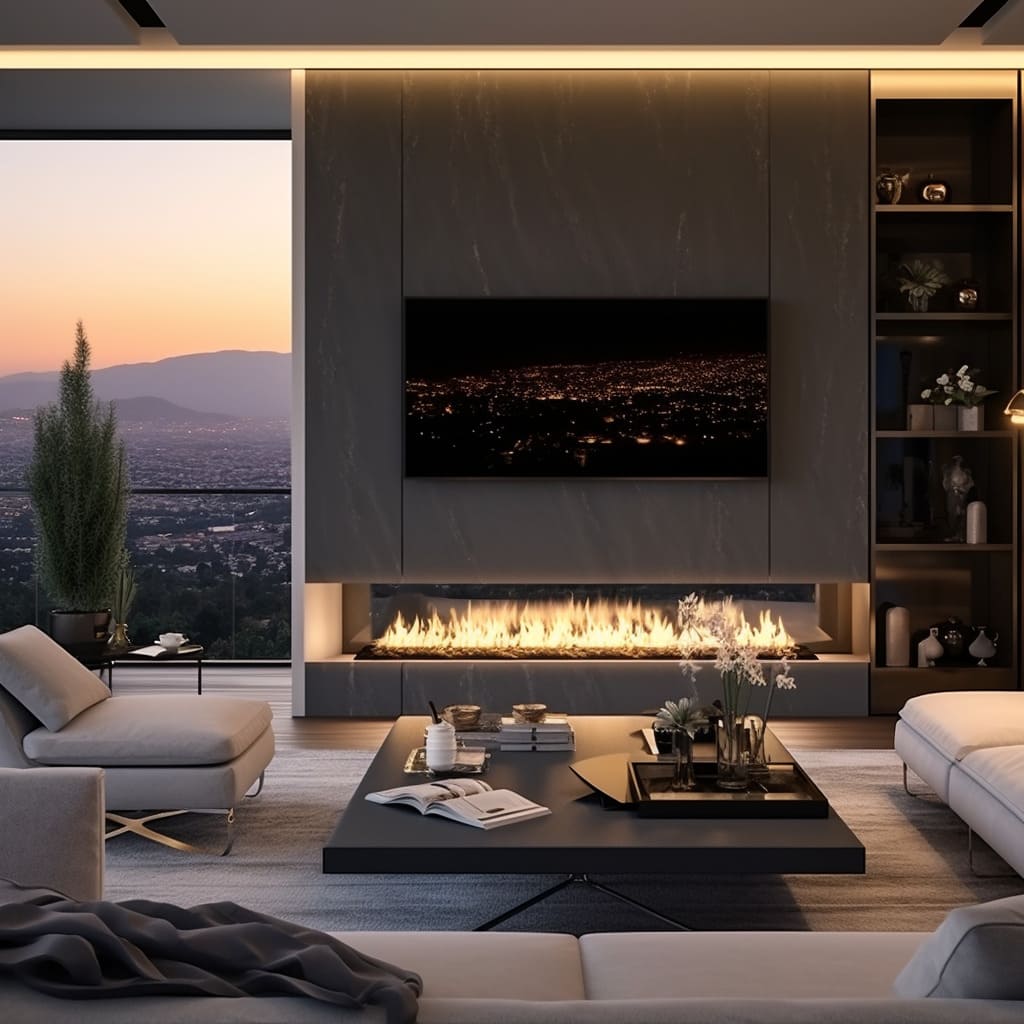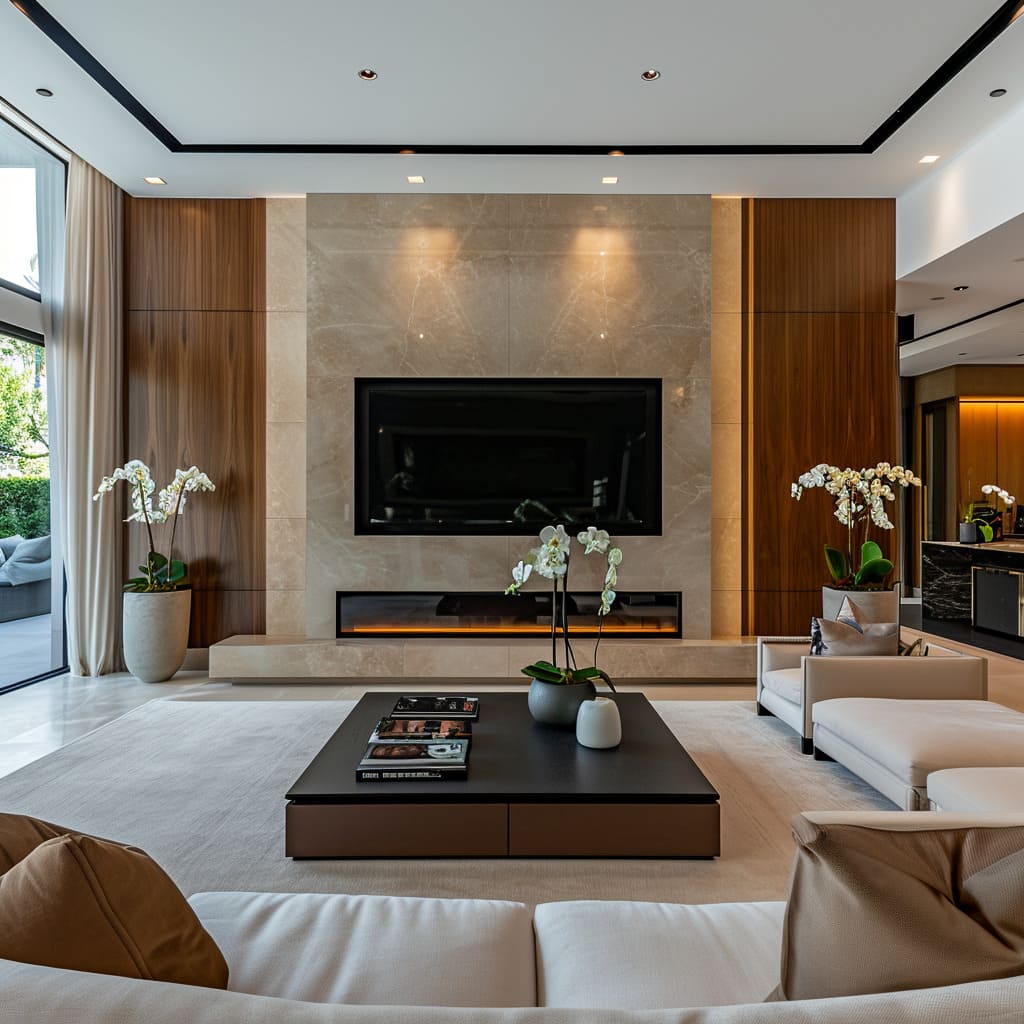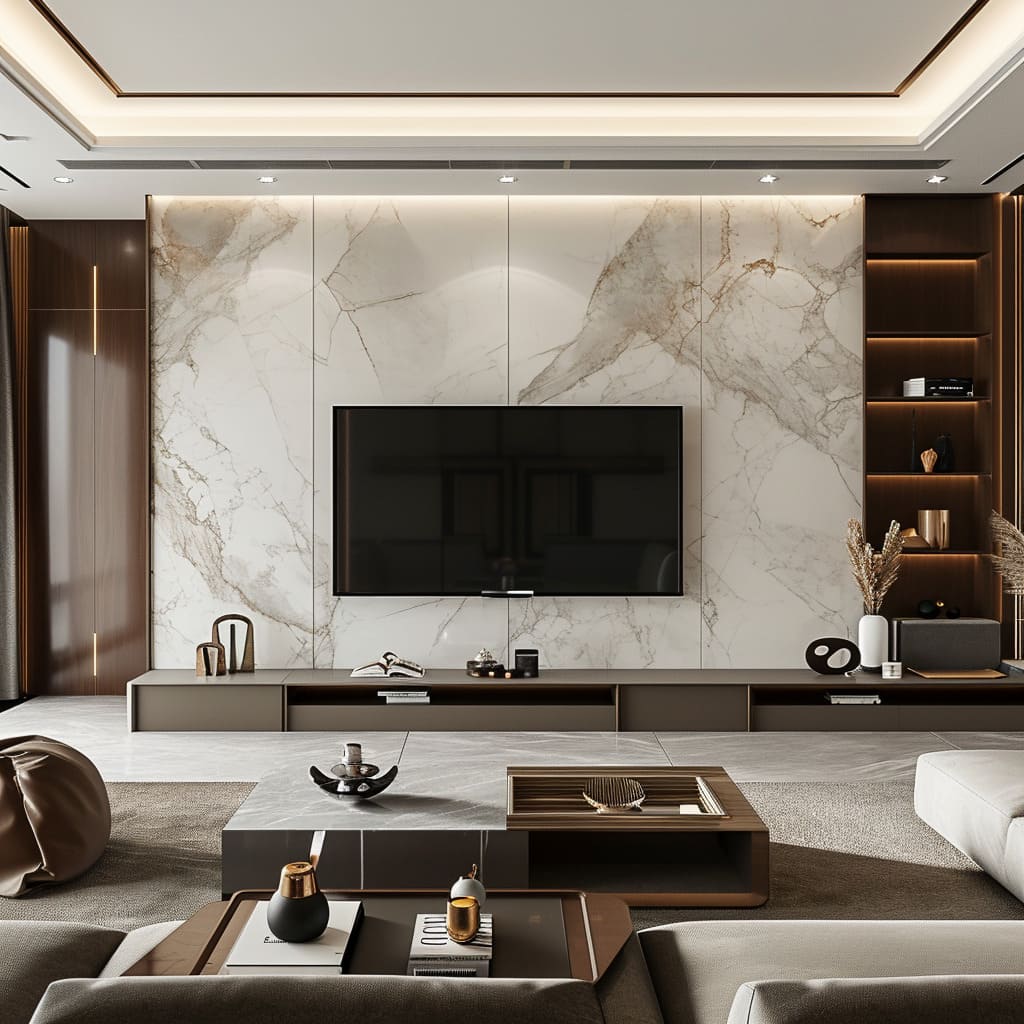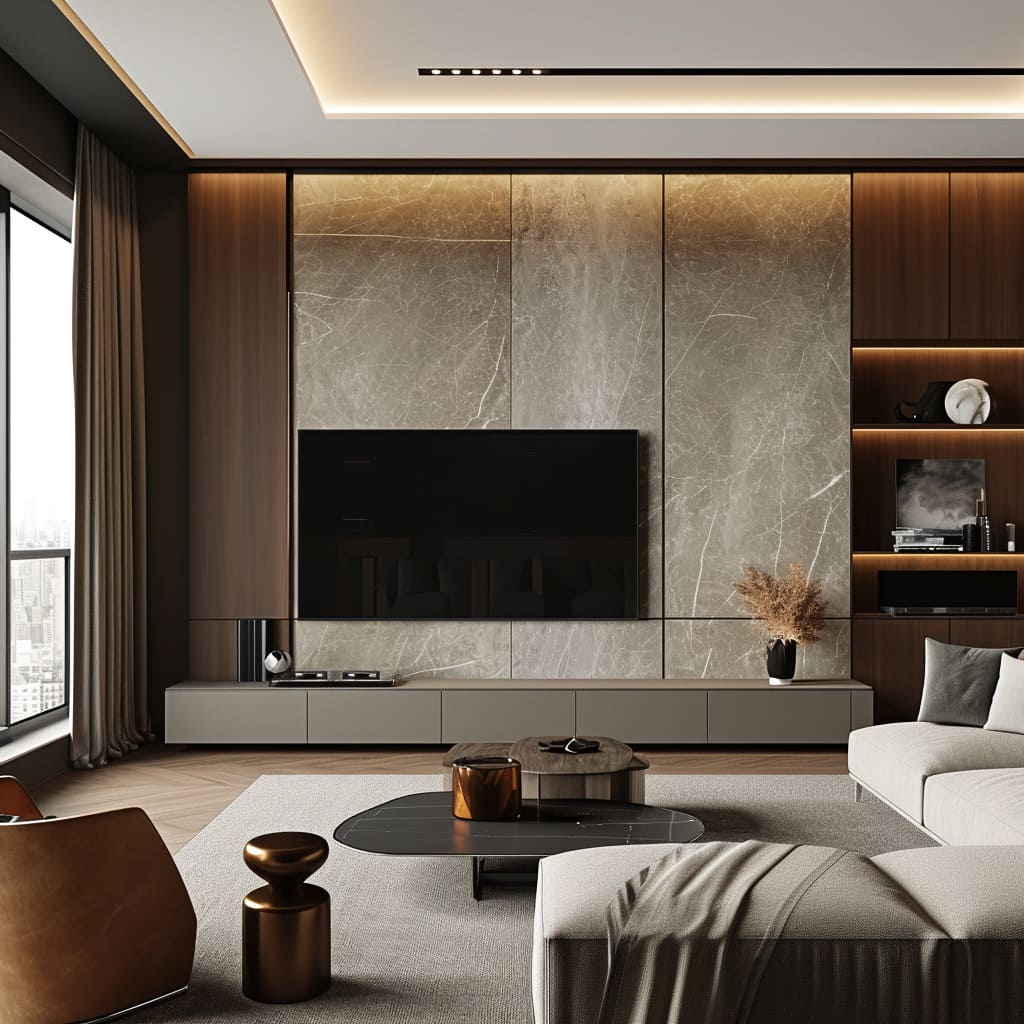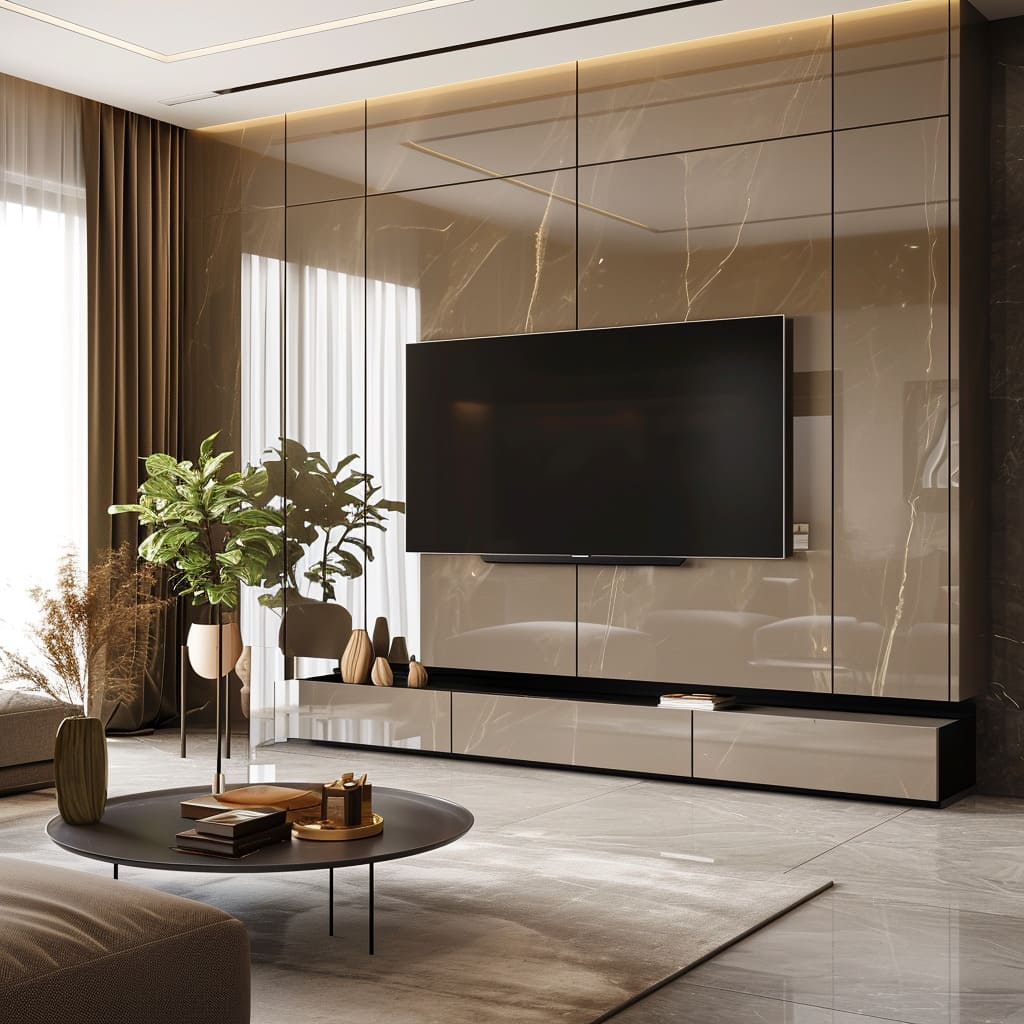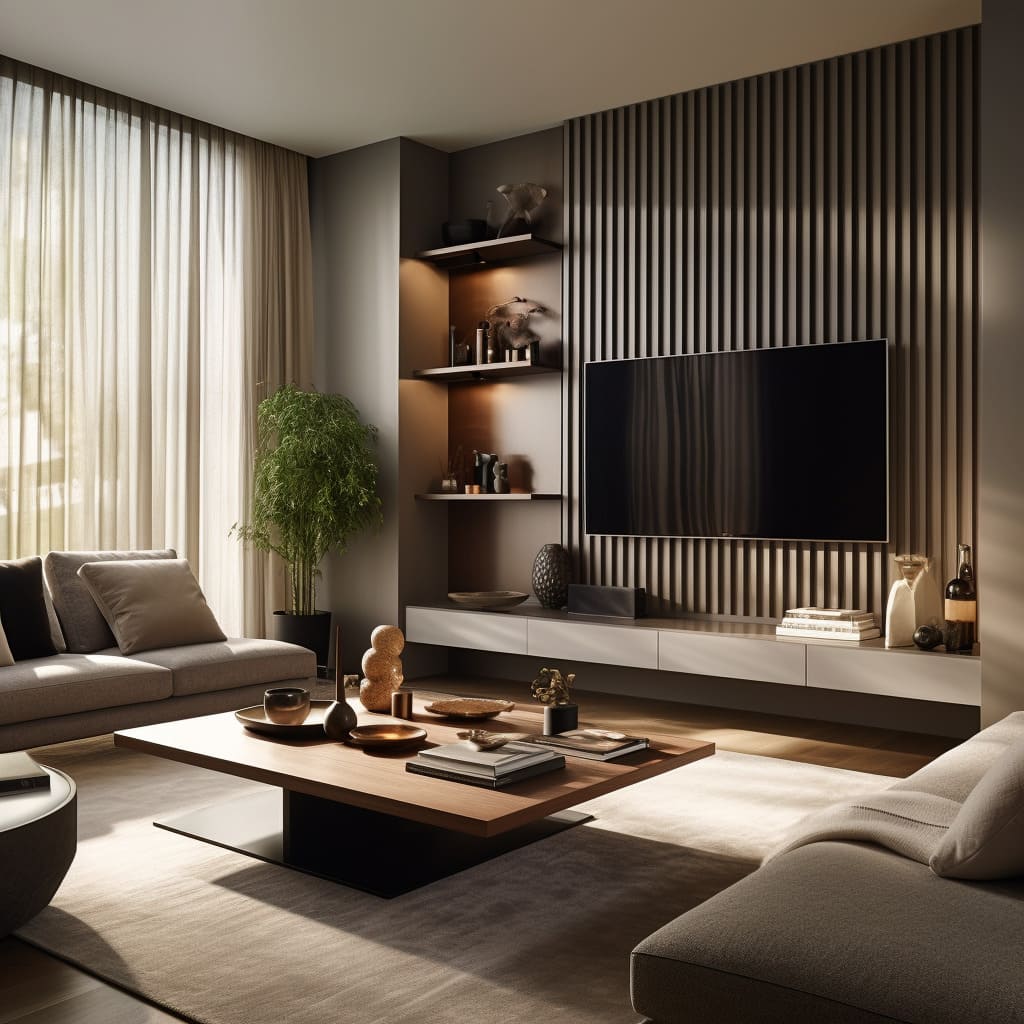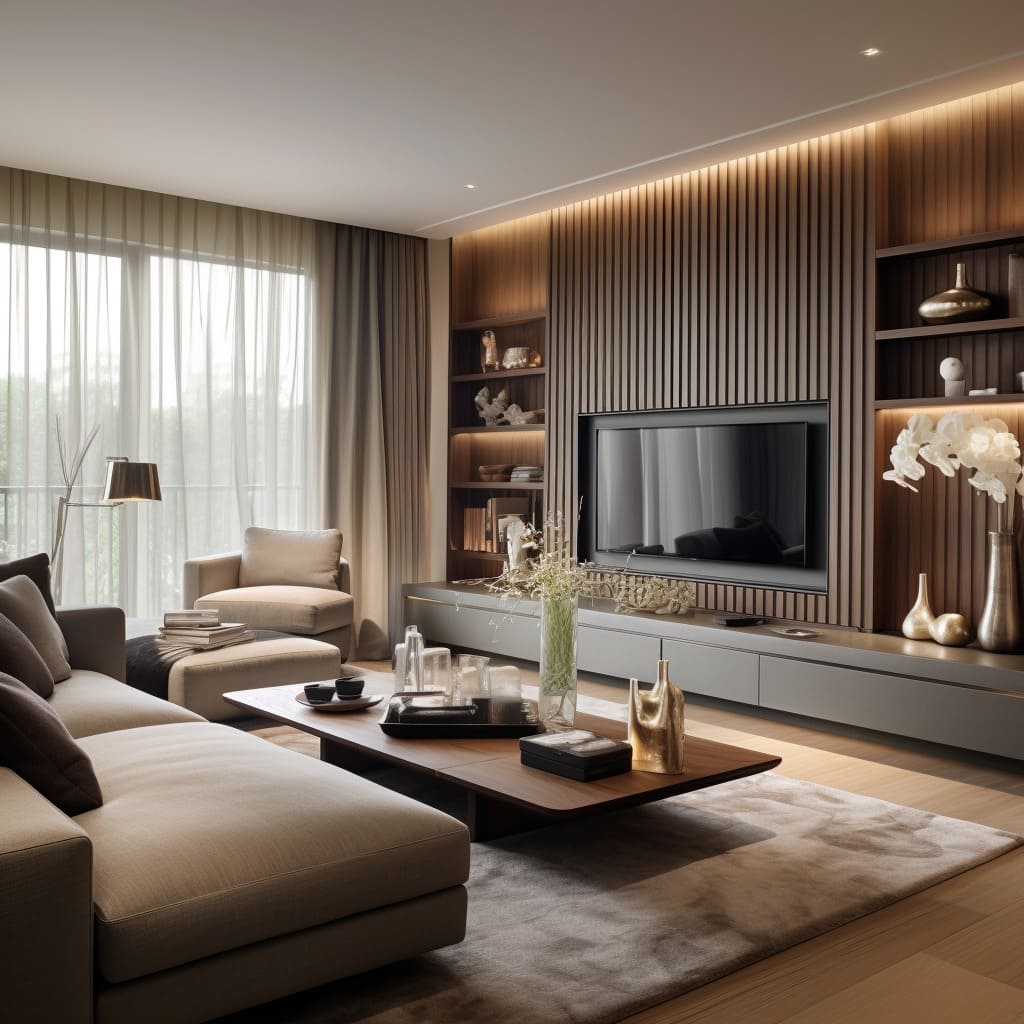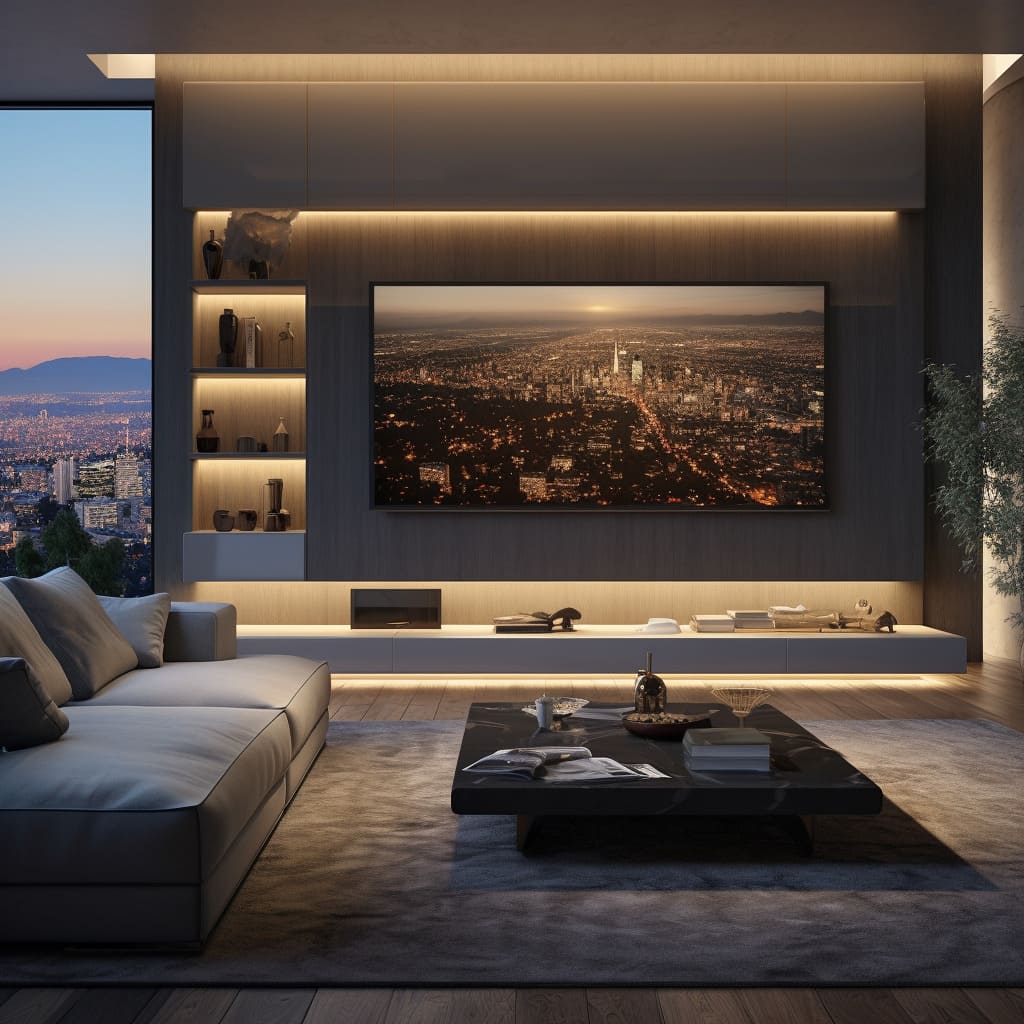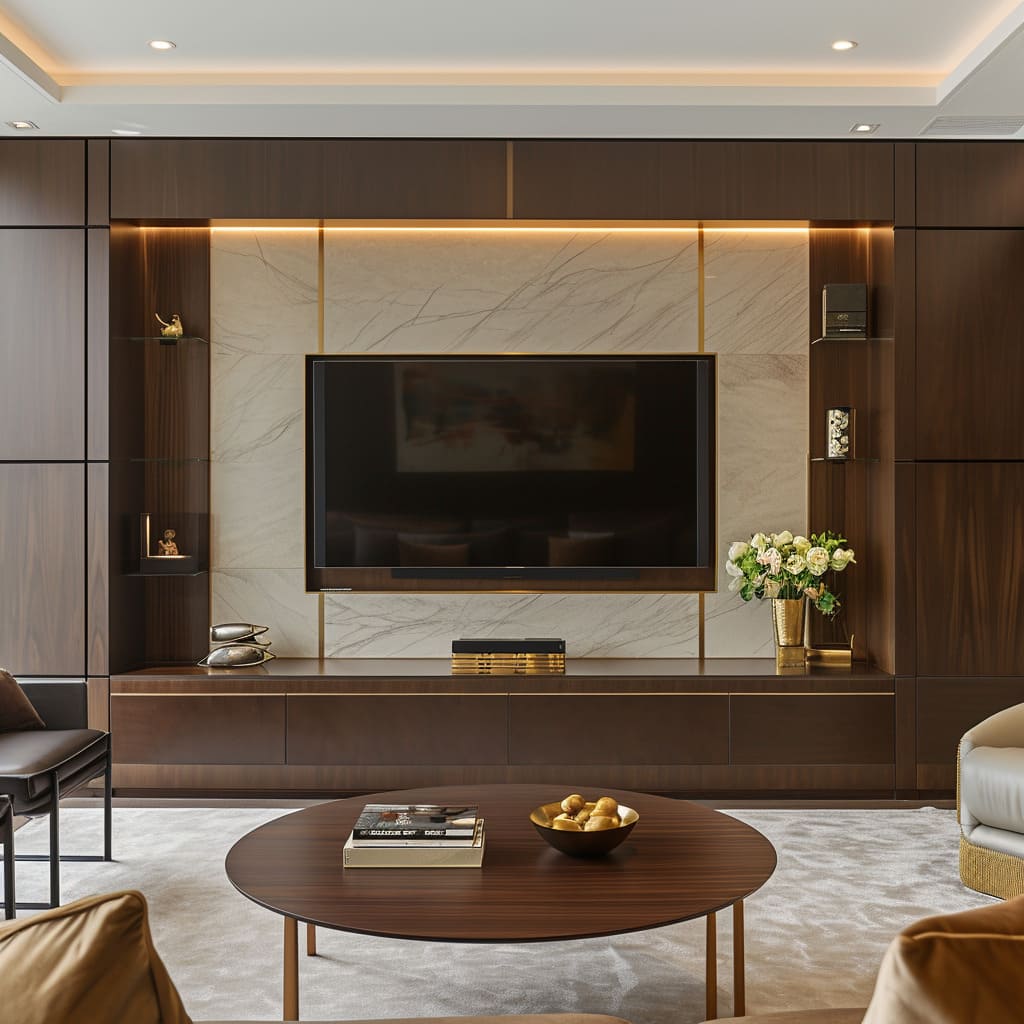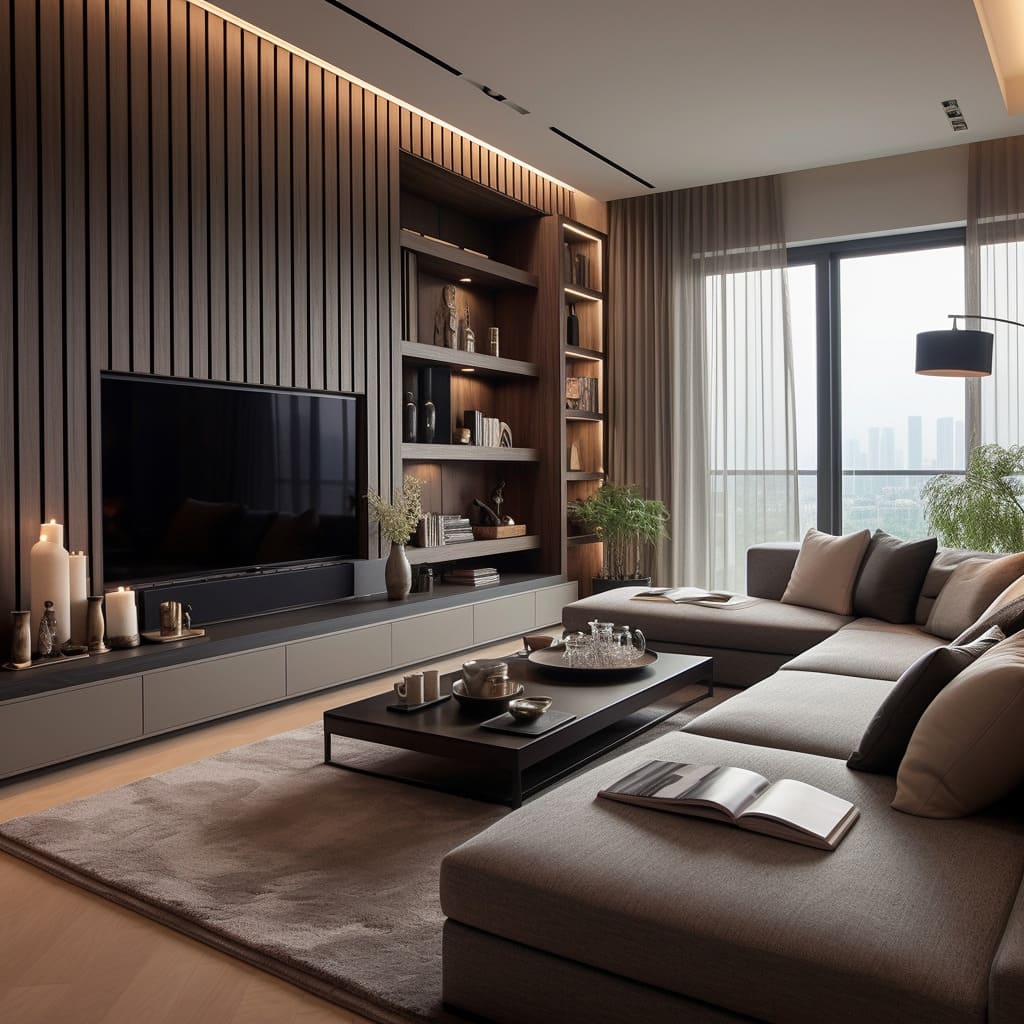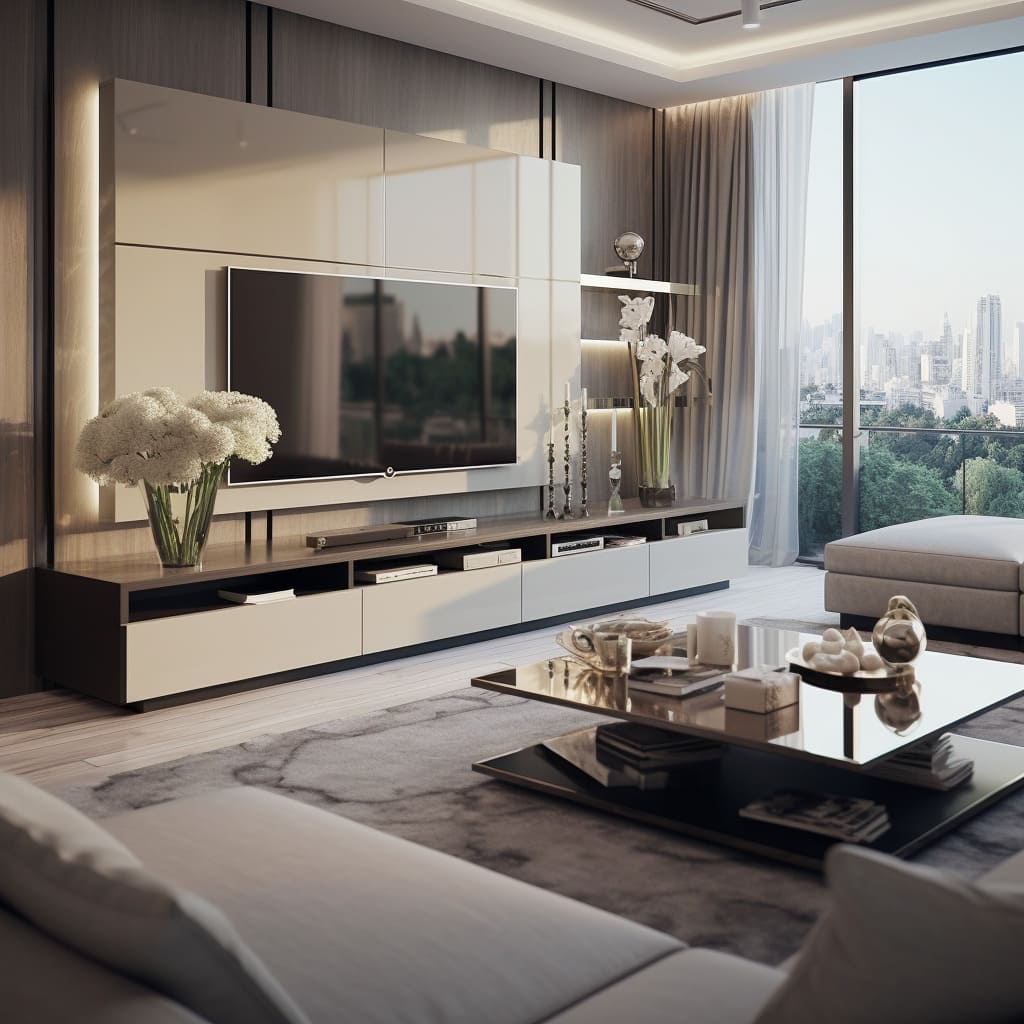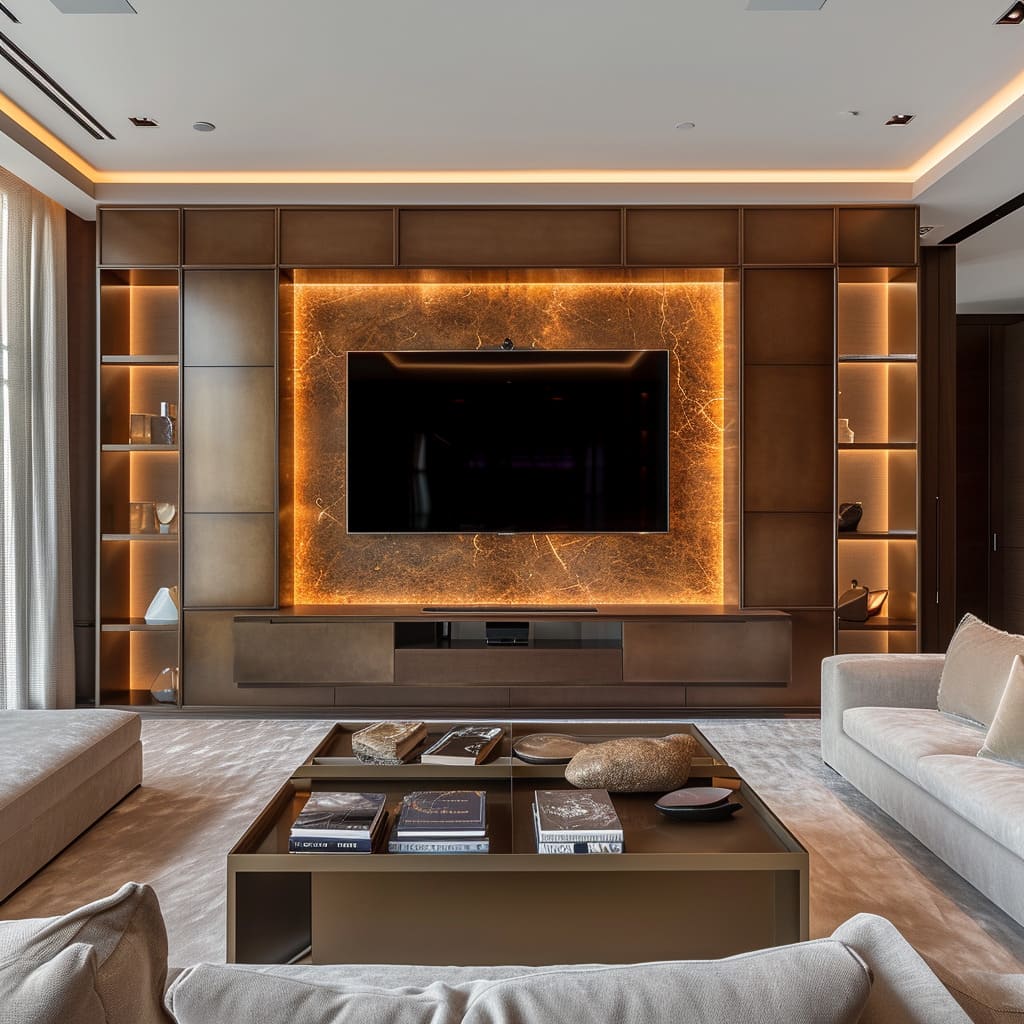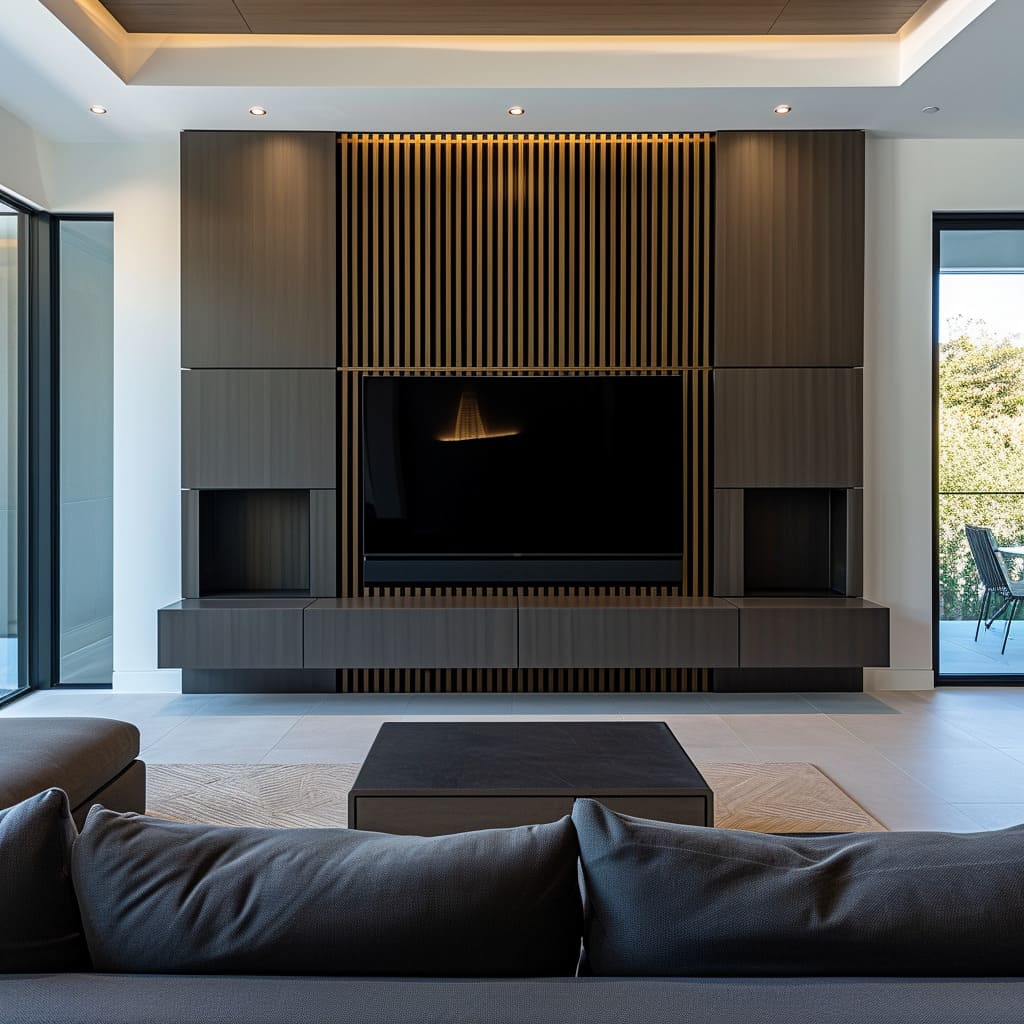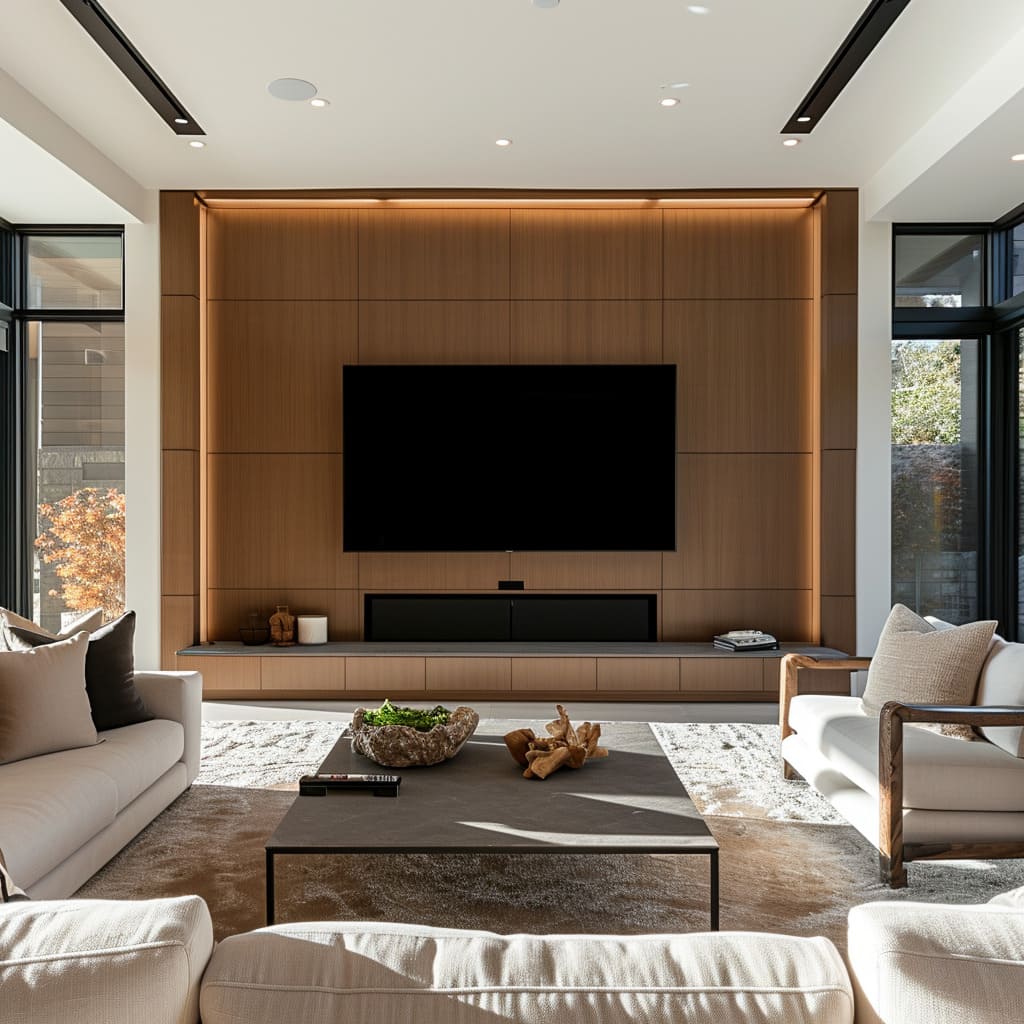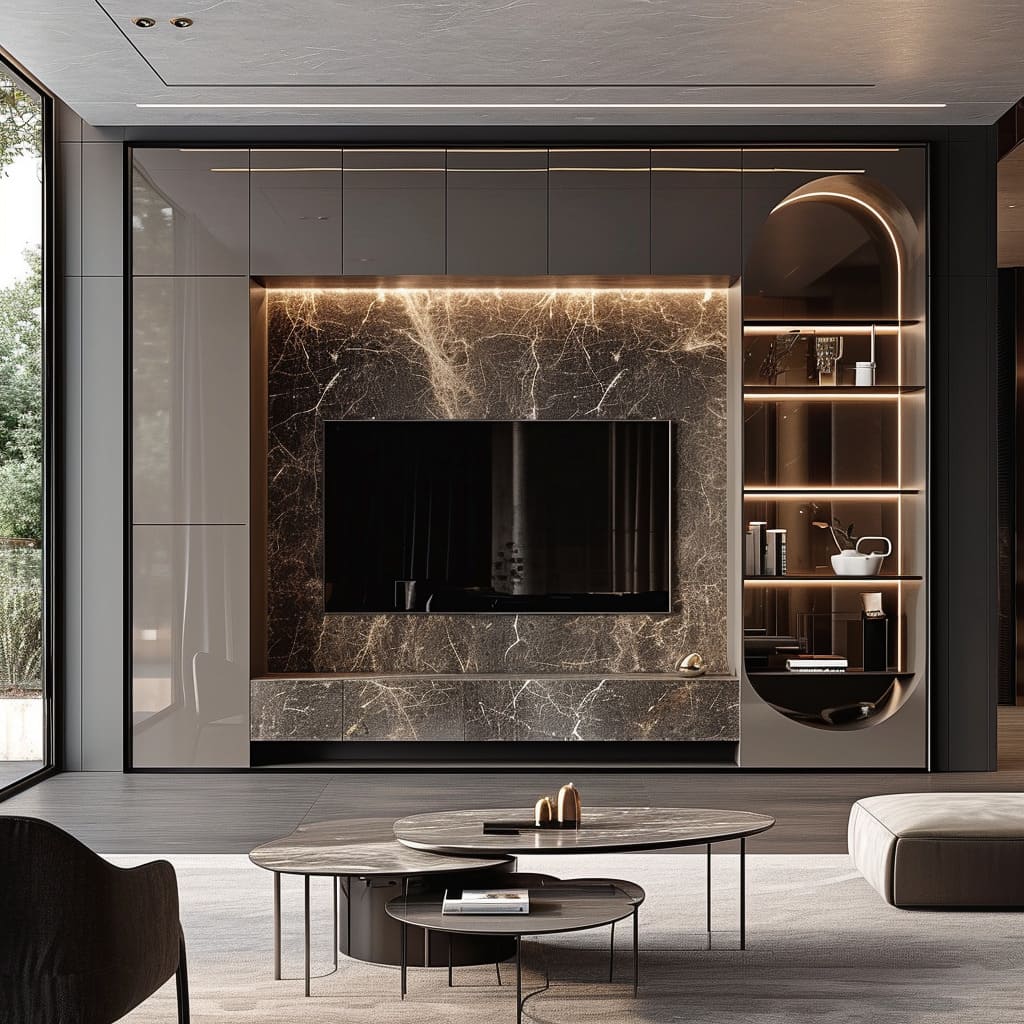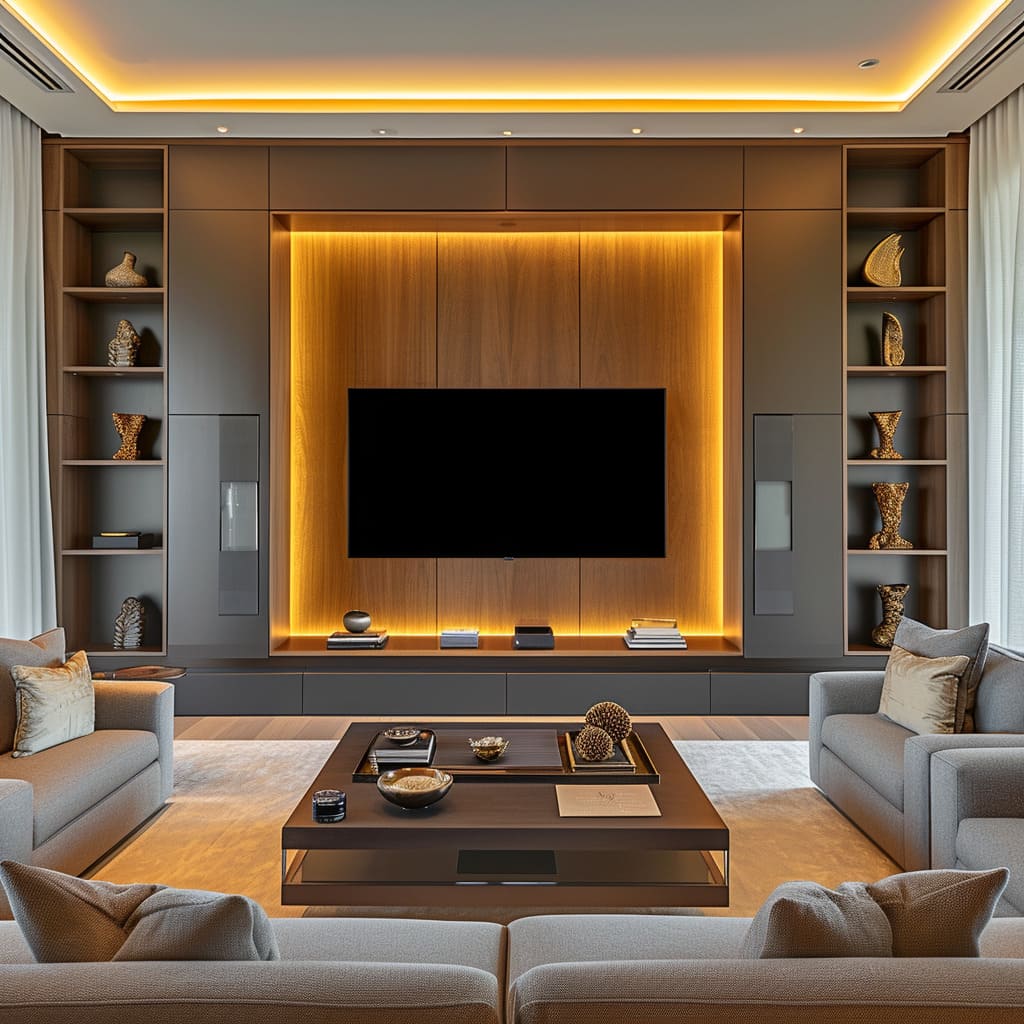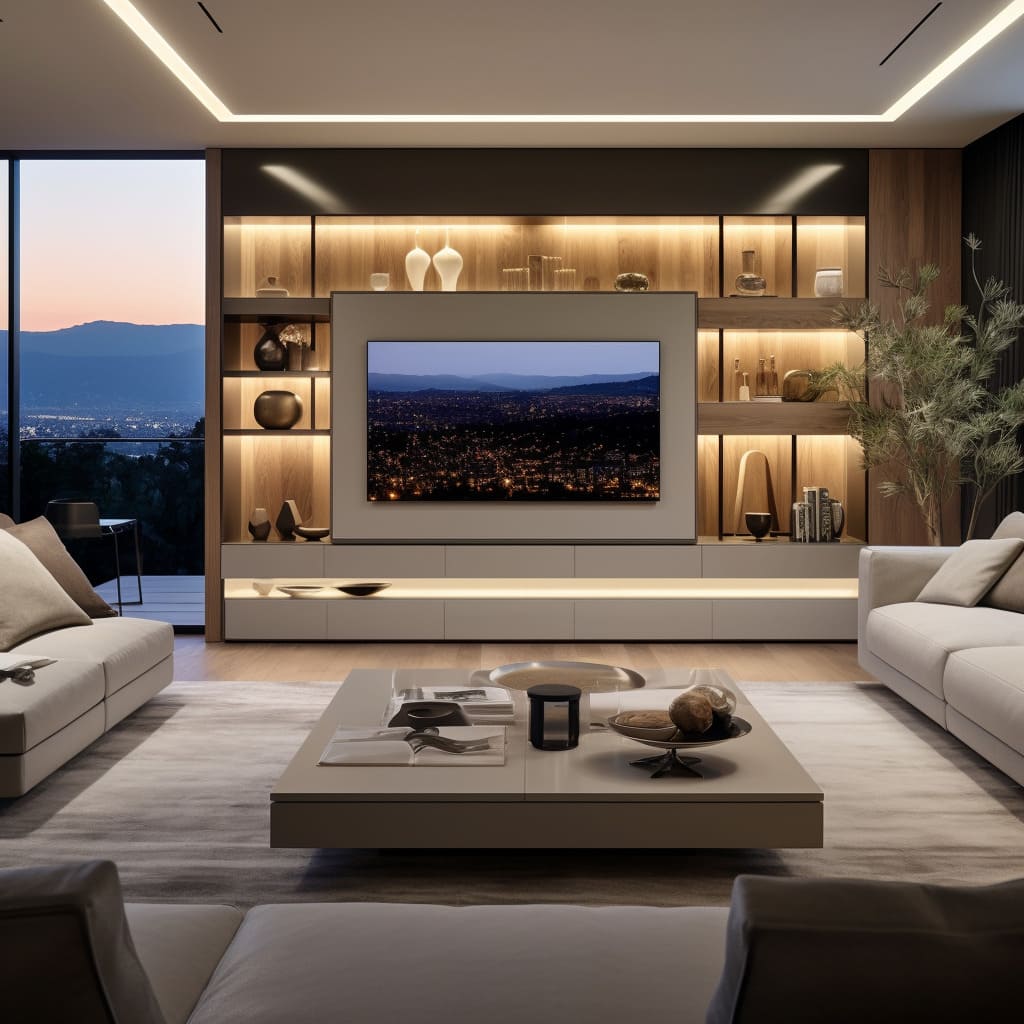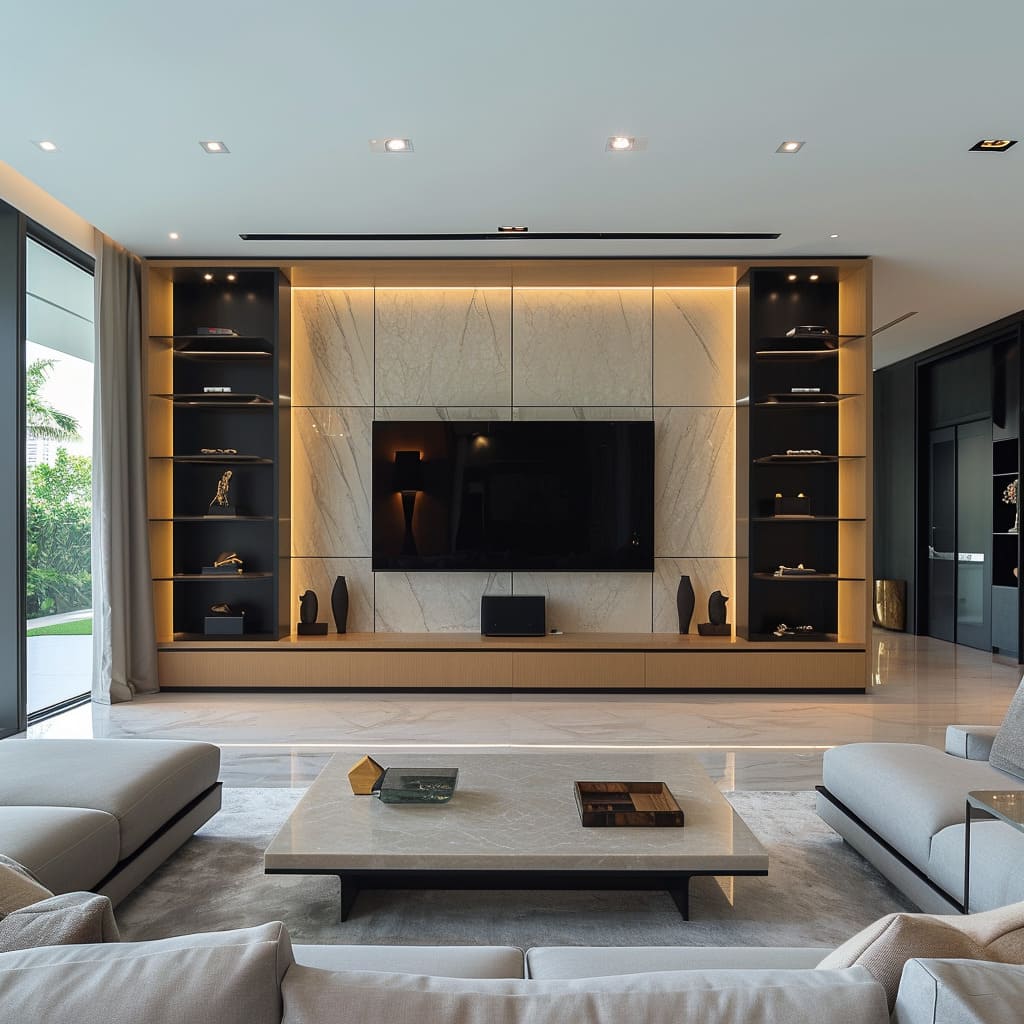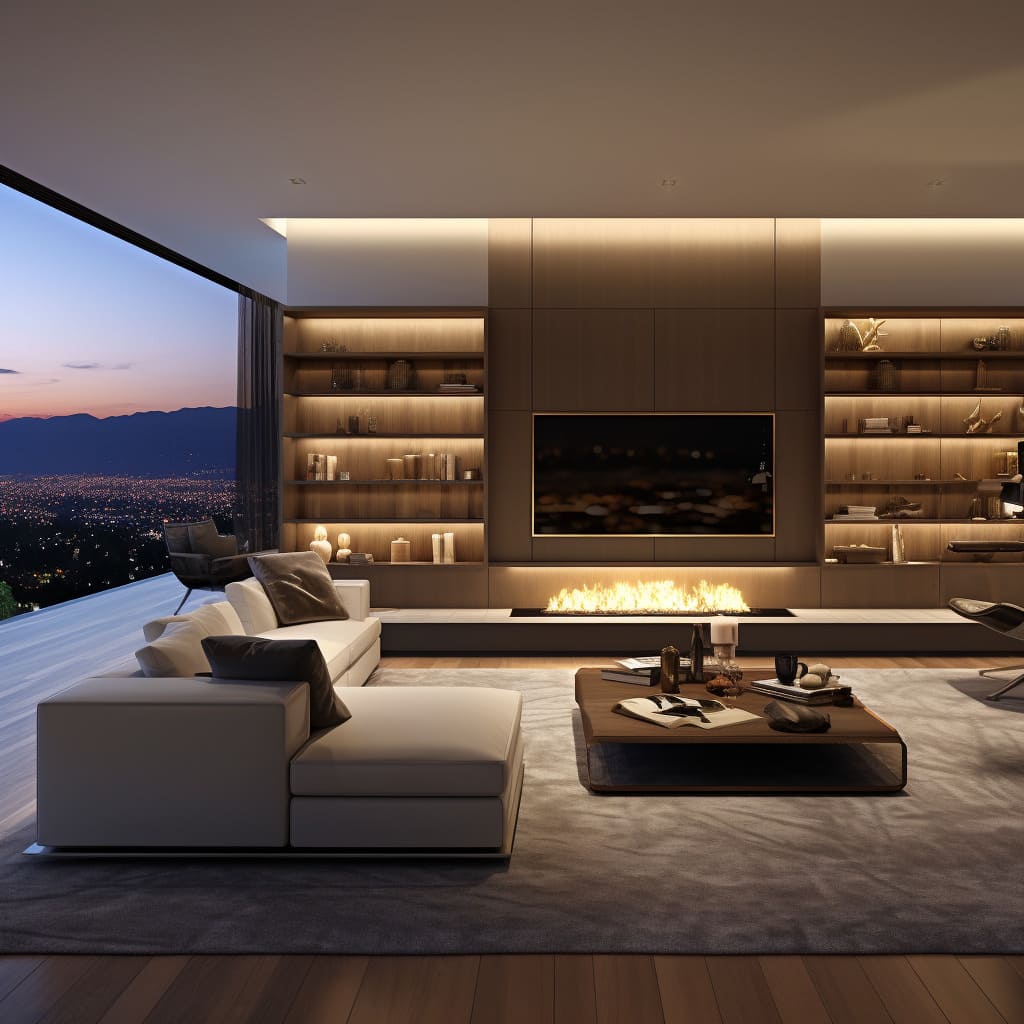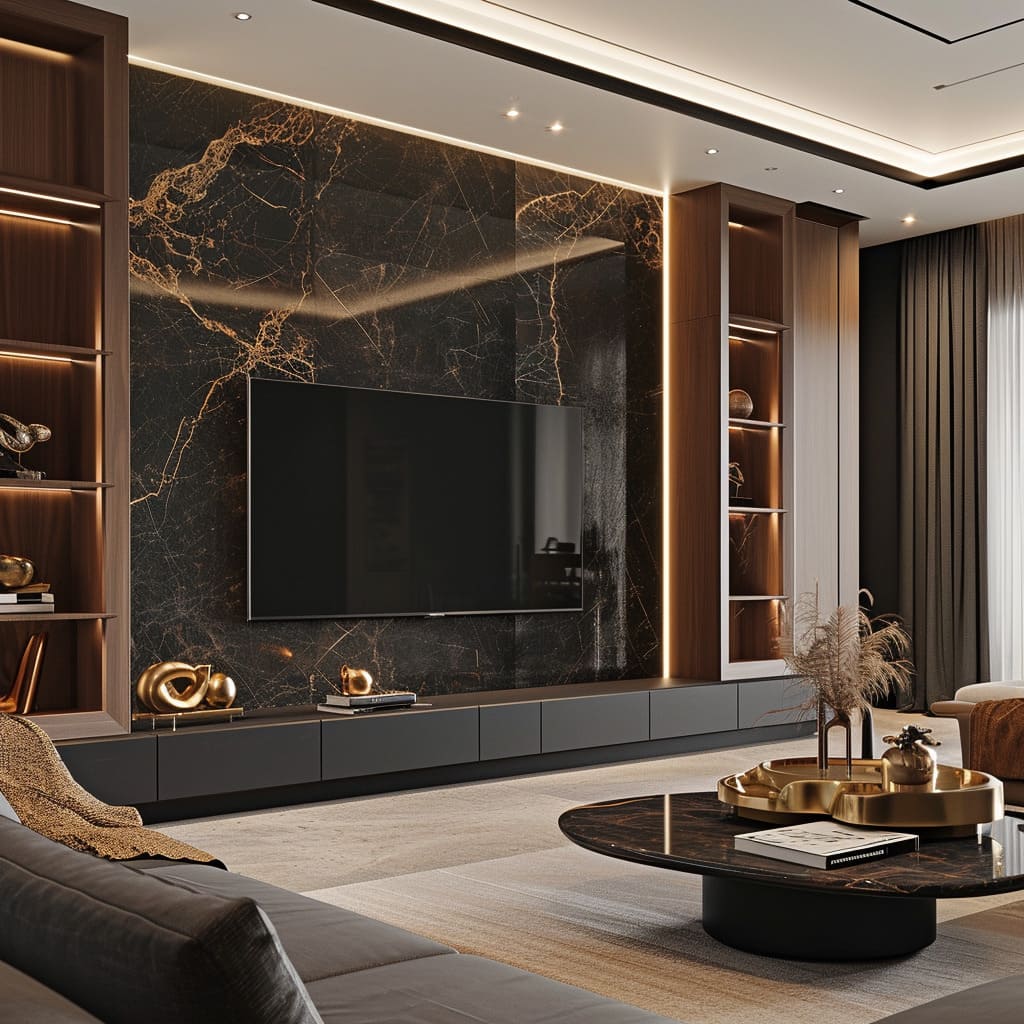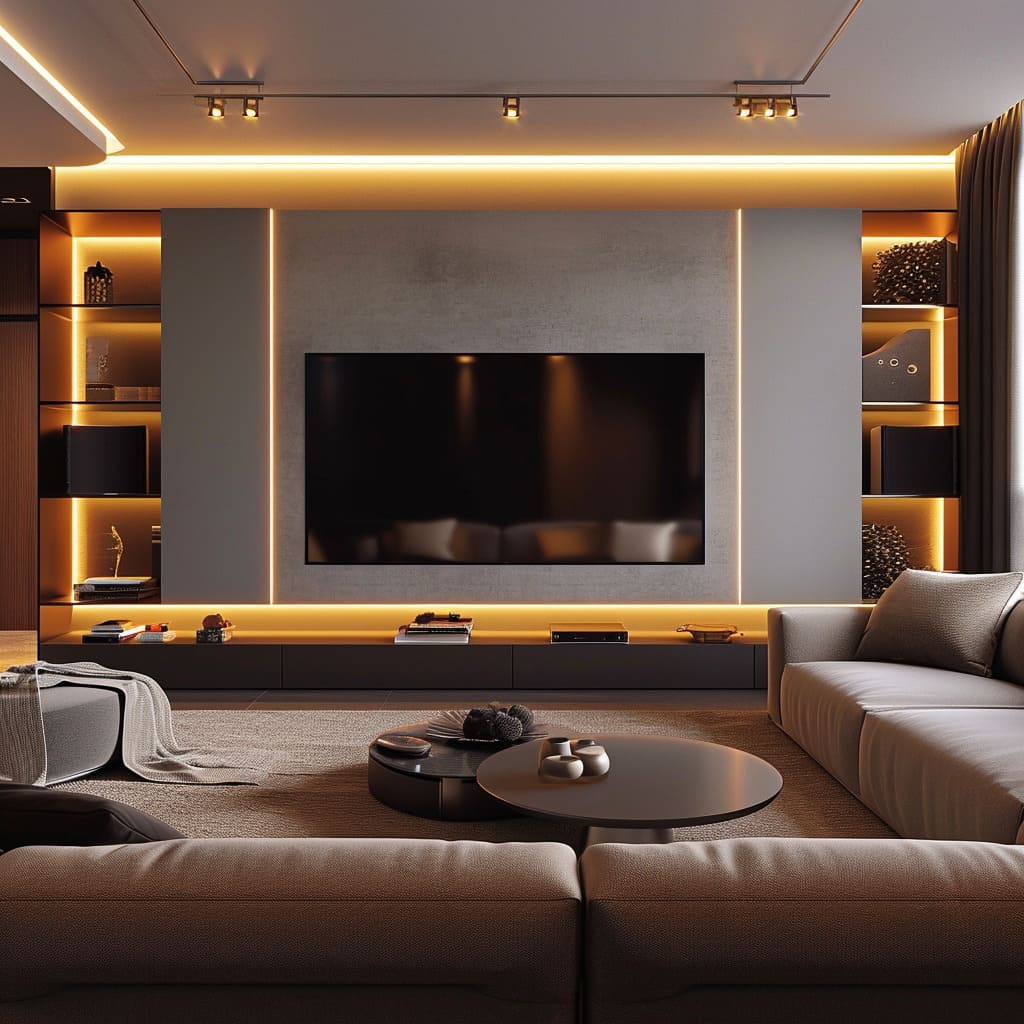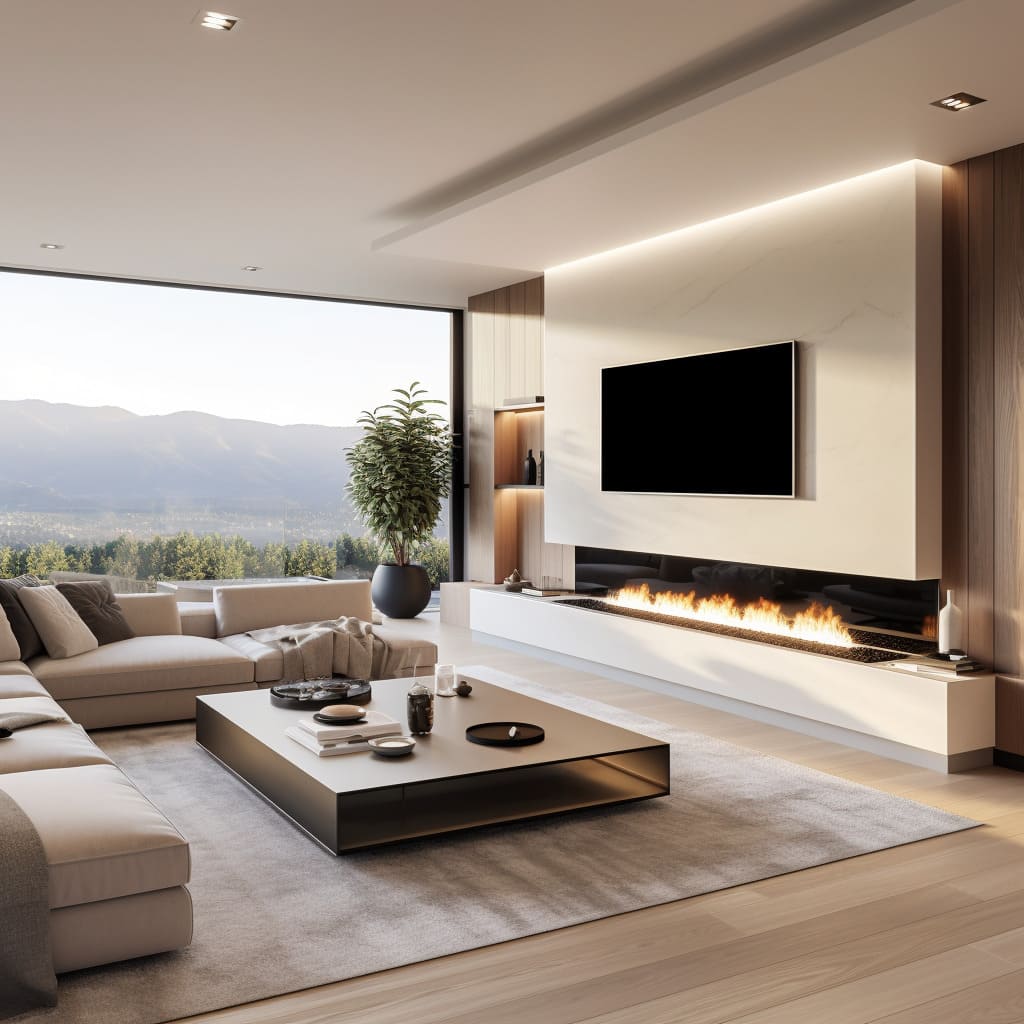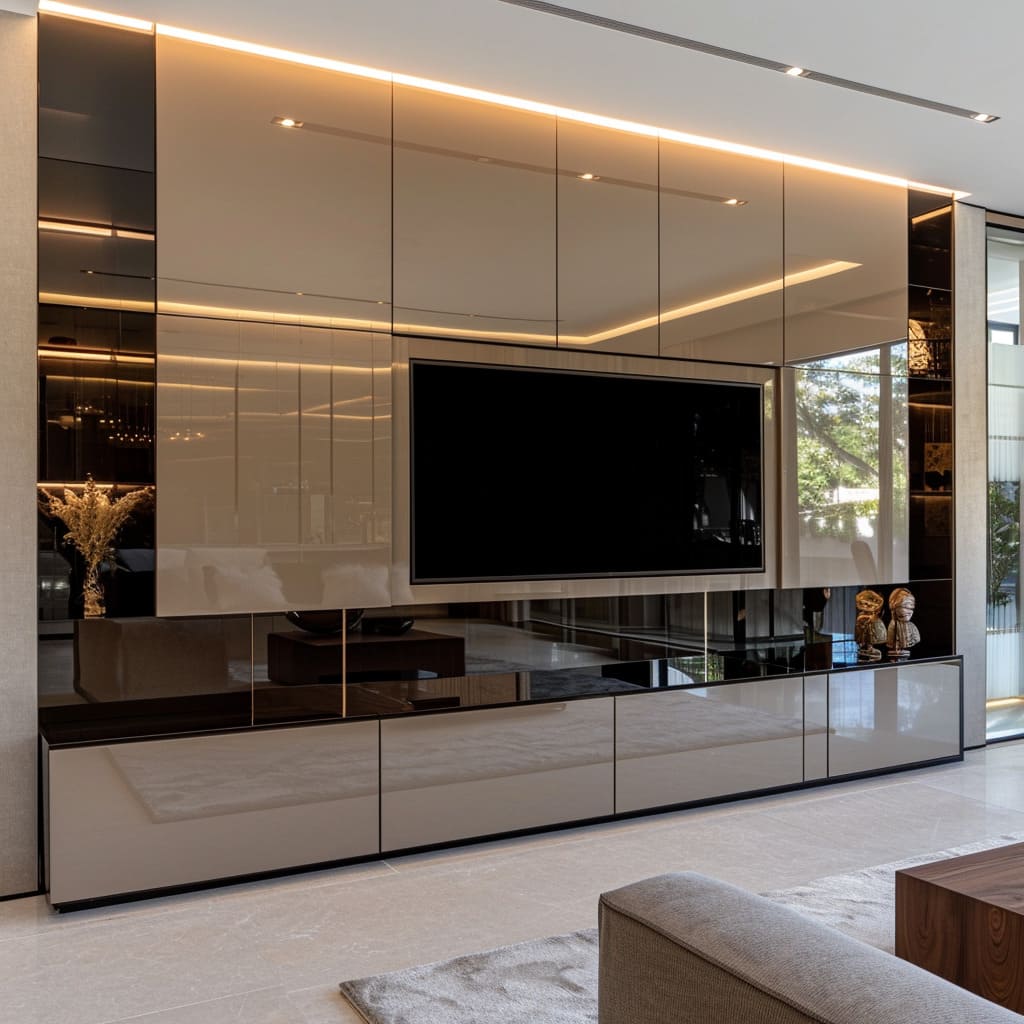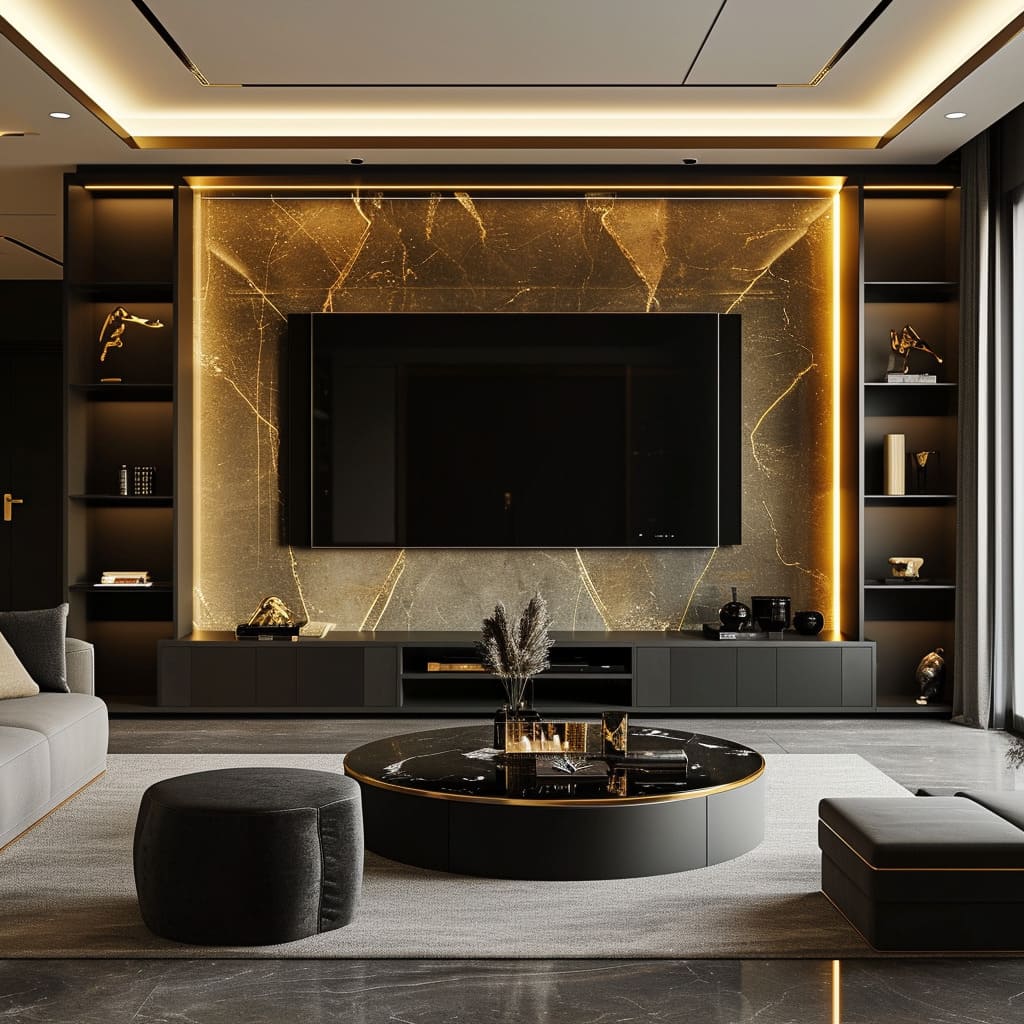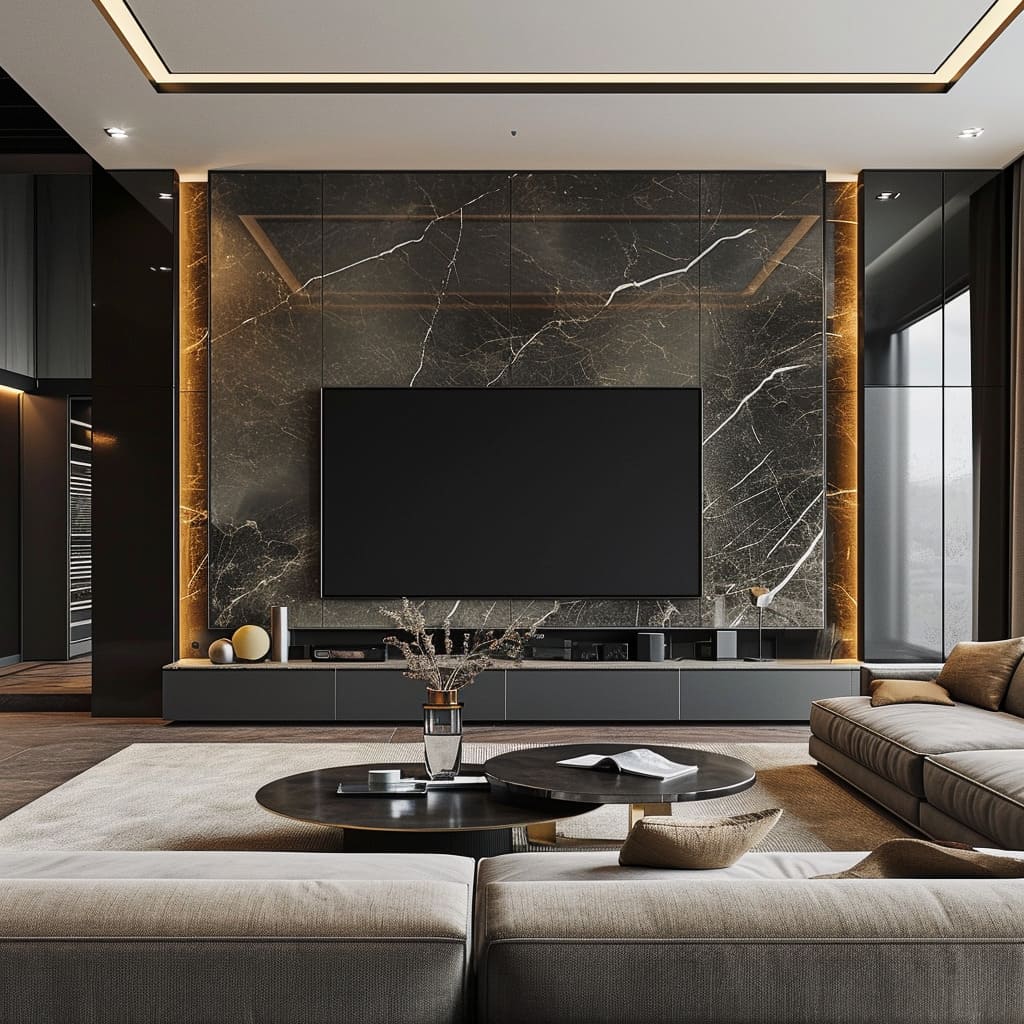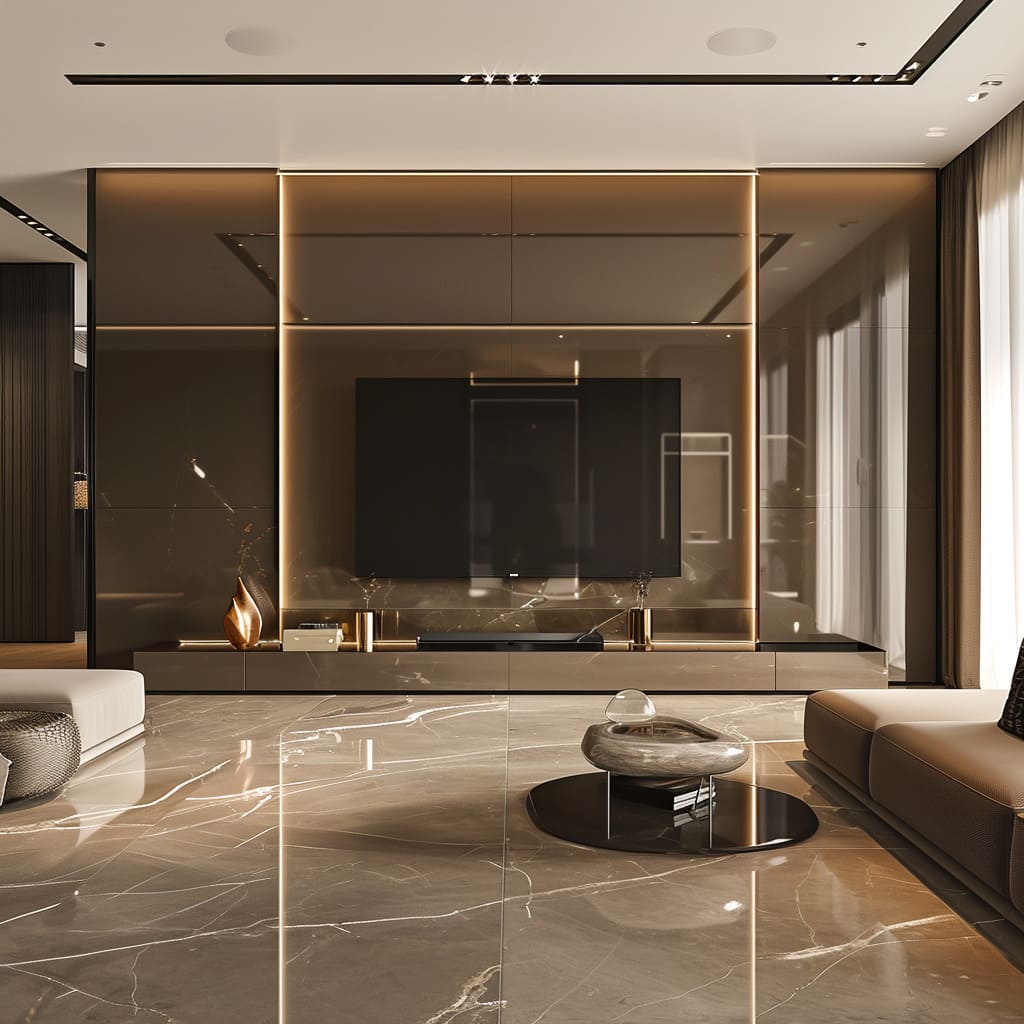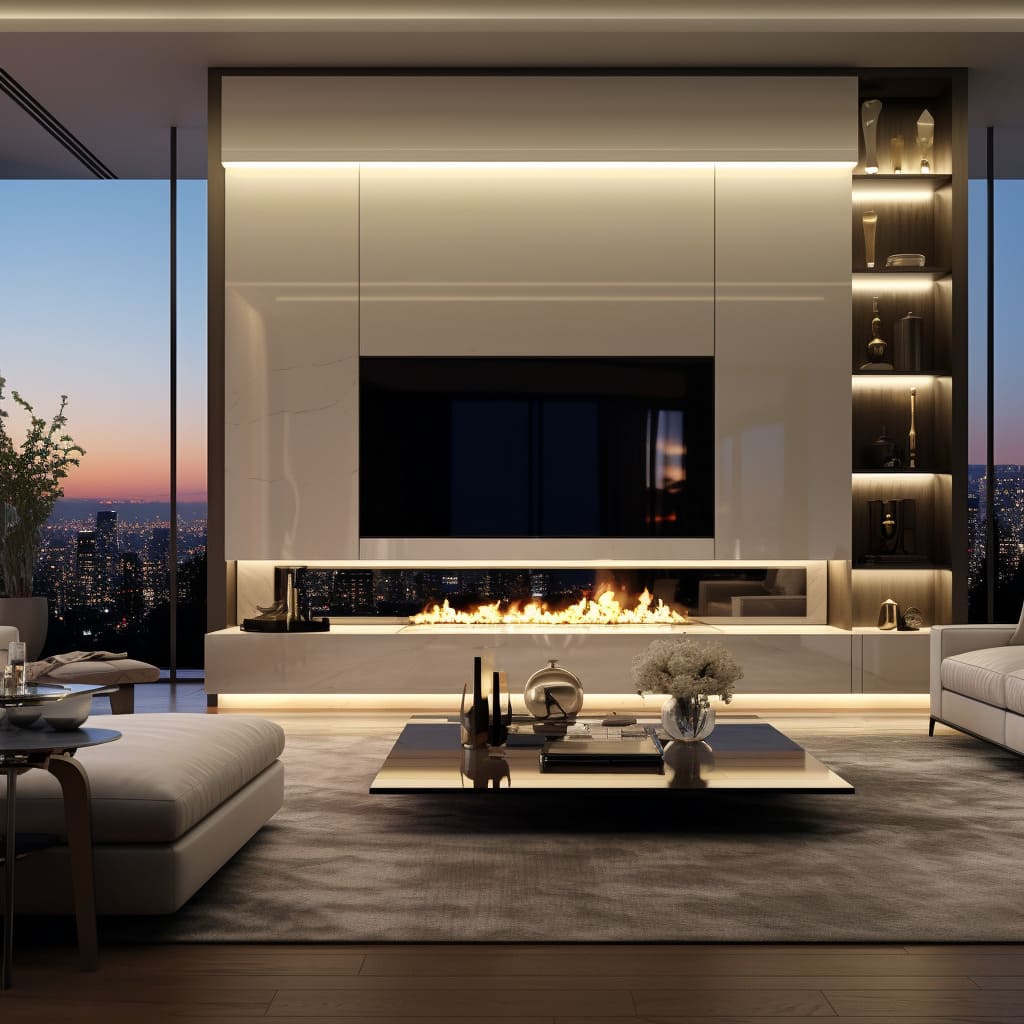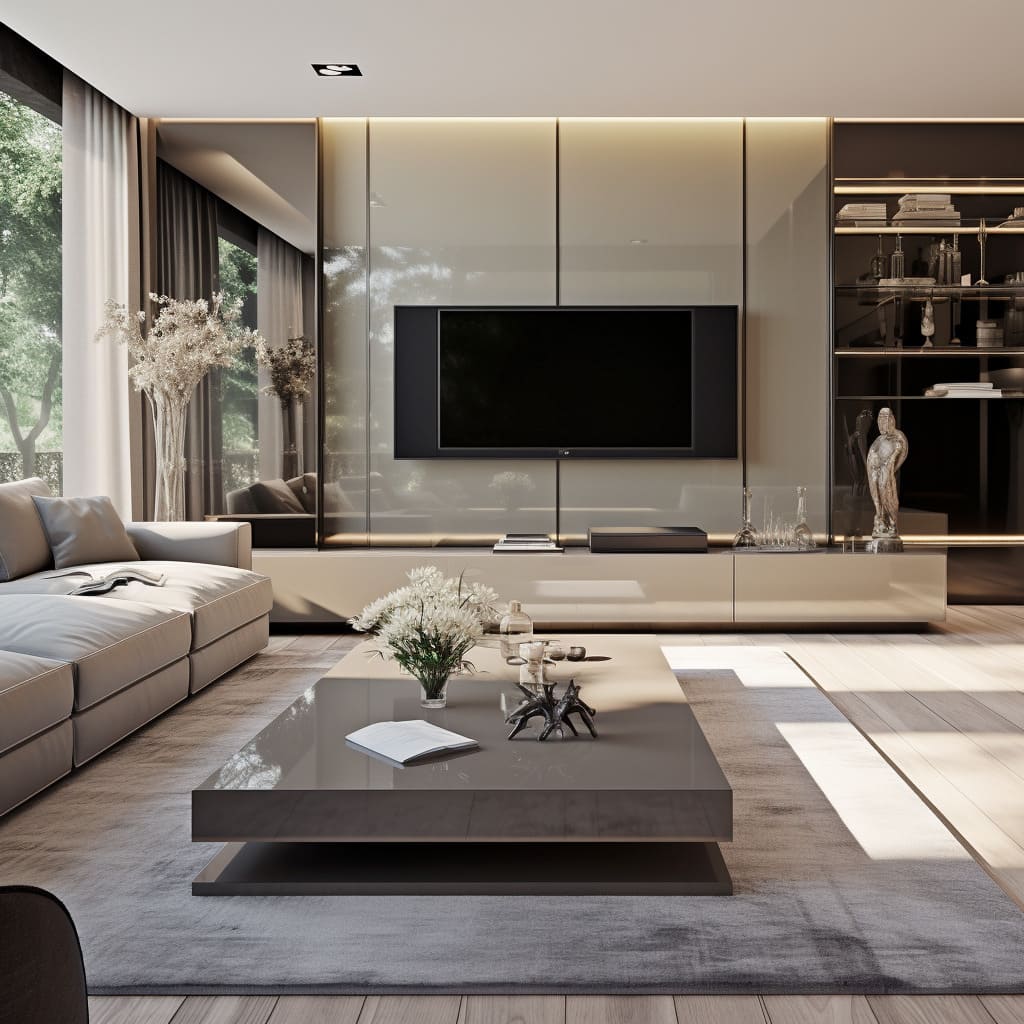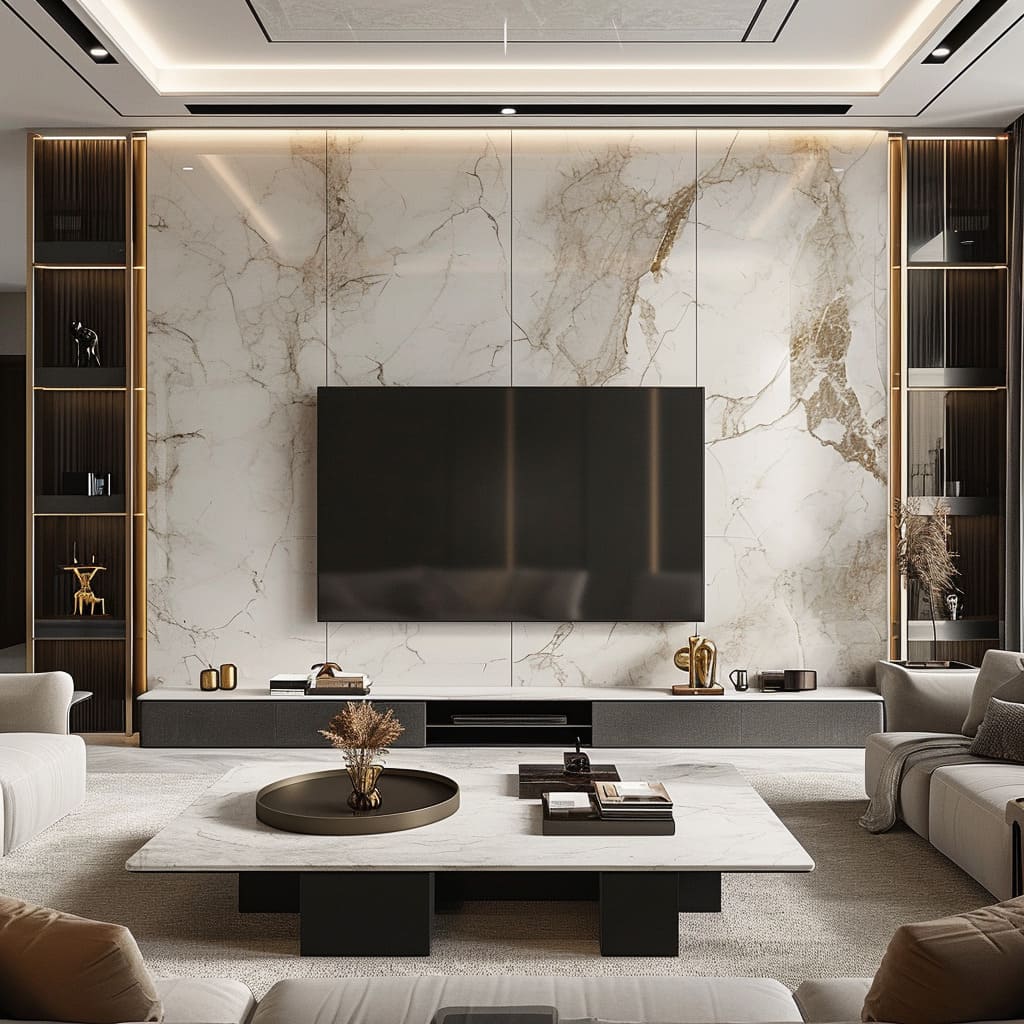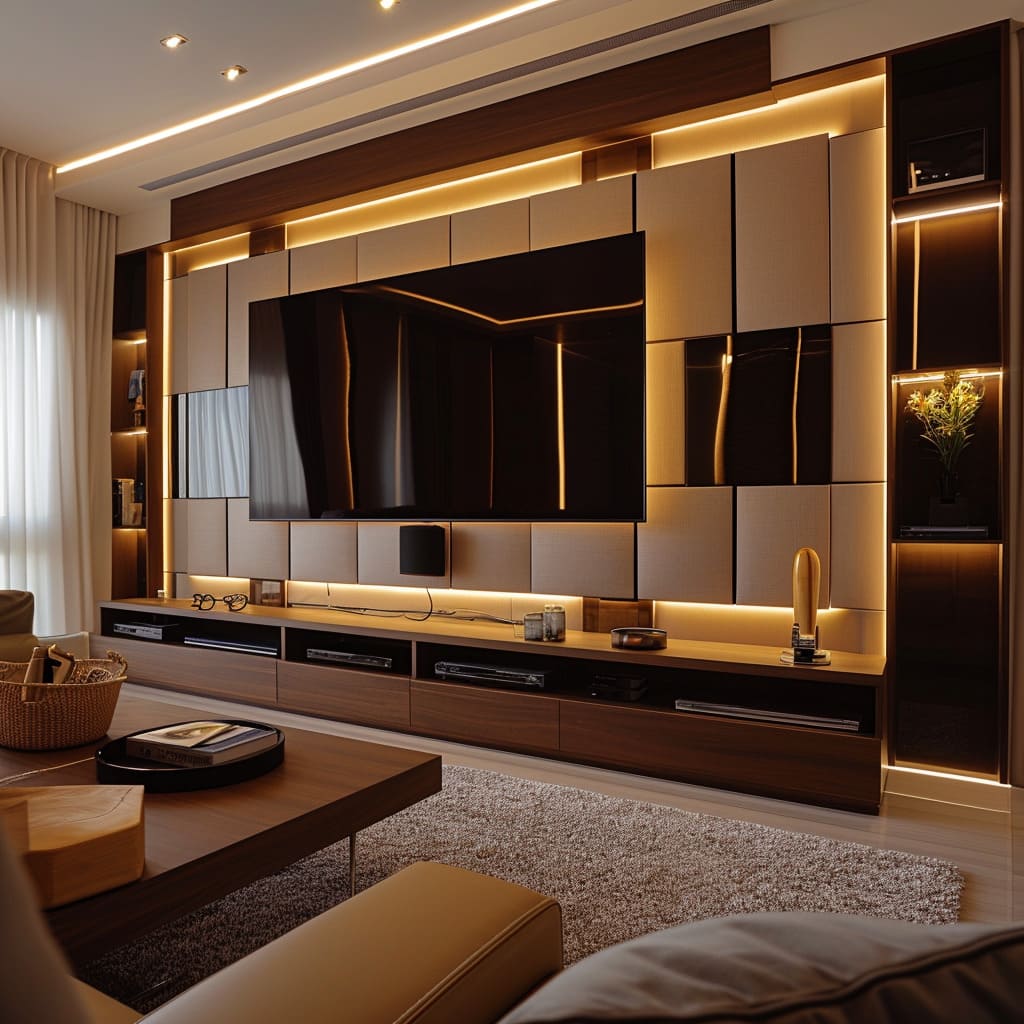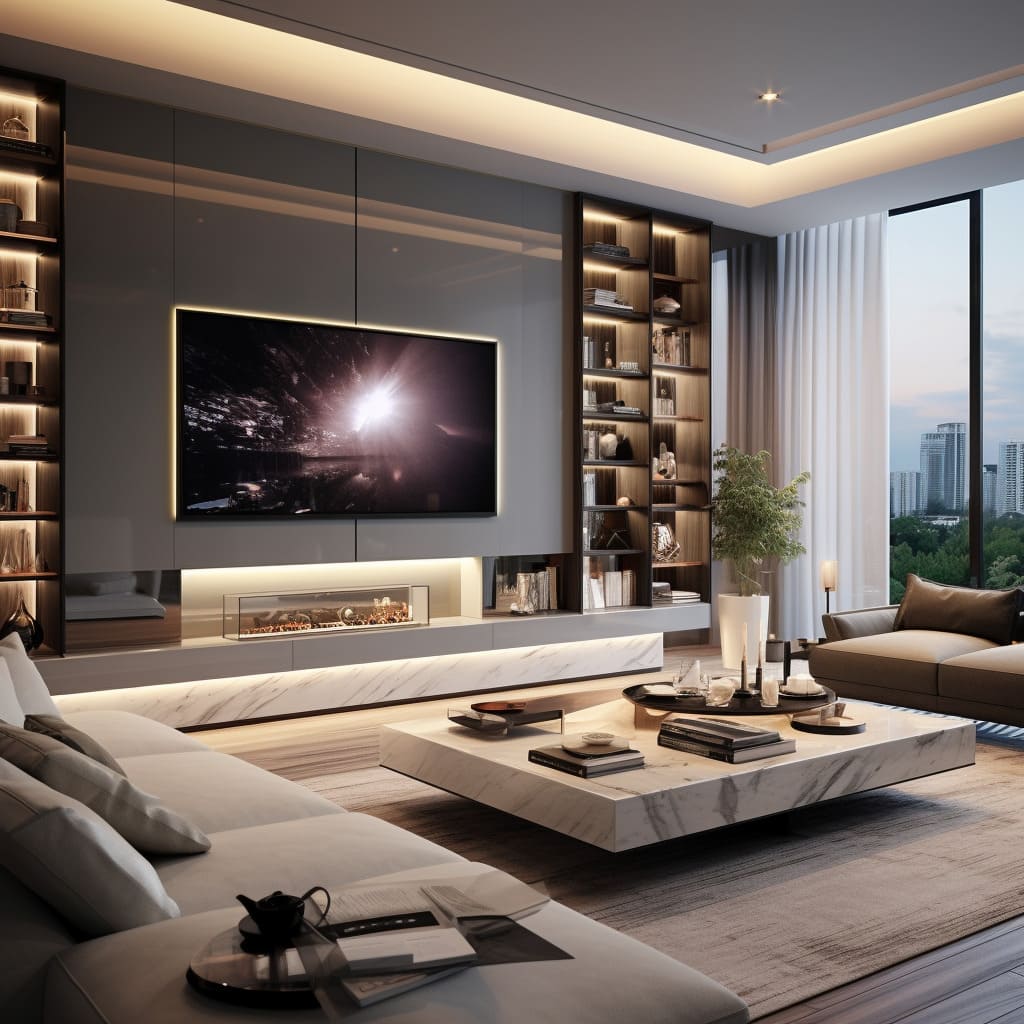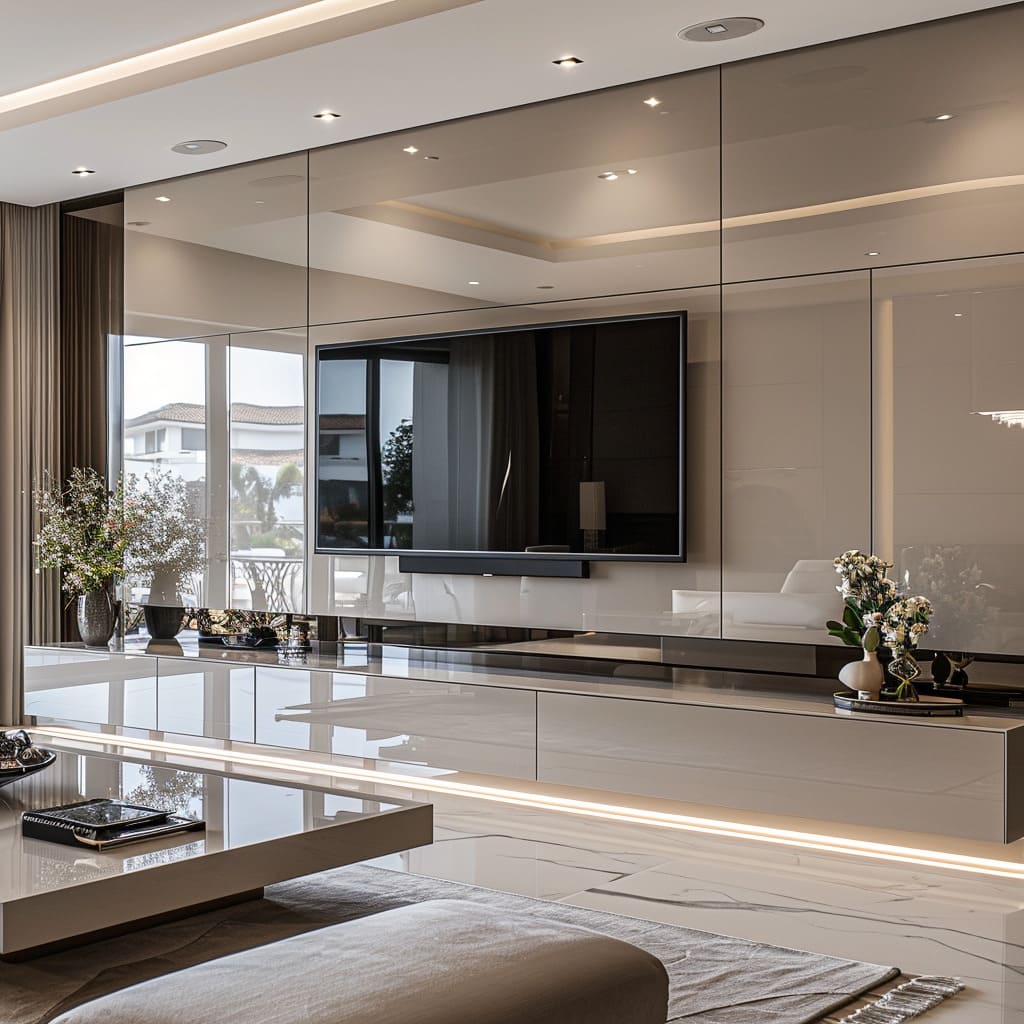In the ever-evolving landscape of interior design, one aspect that consistently captures the imagination of designers and homeowners alike is the integration of technology into living spaces. This fascination has led to the emergence of a unique design element that combines functionality with aesthetic appeal: the TV wall unit.
As we delve into the world of interior design, it becomes evident that these TV wall units are not merely functional components but pivotal focal points that can significantly influence the ambiance and character of a room.
The concept of the TV wall unit has transcended its traditional role, evolving from a simple, utilitarian structure into a sophisticated and central feature of modern homes. These units, with their diverse materials, intricate designs, and innovative lighting solutions, offer more than a place to house a television; they serve as an artistic expression, a statement piece that reflects the homeowner’s style and the designer’s vision.
This article explores the multifaceted world of TV wall units, highlighting how they have become integral to the creation of luxurious and contemporary living spaces. Through a detailed examination of various design strategies and material choices, we aim to provide insights into how these elements can transform an ordinary room into a haven of elegance and comfort.
We begin our journey with a look at the use of luxurious materials like marble, porcelain, wood, and the innovative application of LED lighting. Each material brings its unique texture, color, and character to the space, contributing to an overall ambiance of sophistication and warmth.
Marble and porcelain, with their timeless appeal, offer a touch of classic elegance, while wood adds a natural, organic feel. LED lighting, on the other hand, introduces a modern, dynamic element that enhances both the functionality and aesthetics of these units.
The design of TV wall units is as much about form as it is about function. As we explore these designs, we will delve into how the strategic placement of these units, along with their design intricacies, can influence the room’s layout and overall atmosphere.
We will examine how the integration of wooden strips, the play of light and shadow, and the selection of color temperature in LED lighting can create different moods and effects, from a cozy, inviting ambiance to a sleek, sophisticated look.
Furthermore, we will look at how these TV wall units can be personalized to reflect the homeowner’s tastes and lifestyle. From showcasing cherished possessions on shelving to selecting materials that resonate with the individual’s aesthetic preferences, these units offer endless possibilities for customization.
In addition to aesthetic considerations, practical aspects such as storage, display space, and the integration of technology are also crucial. The designs we discuss will showcase how functionality can be seamlessly blended with style, ensuring that these TV wall units are not only visually striking but also cater to the practical needs of everyday living.
As we navigate through the nuances of these diverse designs, we aim to provide a comprehensive guide to incorporating TV wall units into modern interior design. Whether you are a professional designer seeking inspiration or a homeowner looking to revamp your living space, this article offers a wealth of ideas and insights into creating living spaces that are both luxurious and comfortable, modern yet timeless.
Reflective Elegance: Designing TV Wall Units with Mirrors, Glass, and High-Gloss Finishes
Central to these designs are elements of mirror and glass. Mirrors, sometimes tinted or finished in bronze, add depth and a dynamic element of light play.
They reflect both natural and artificial light, creating an illusion of a more expansive and lively space. The glass used varies from clear to frosted or subtly tinted, often in shades like gray, bronze, or black, aligning seamlessly with the room’s aesthetic.
These glass pieces are sometimes back-painted or film-coated to attain a specific color effect, lending a sleek, uninterrupted look to the unit.
Another standout material is high-gloss lacquer, known for its reflective and smooth finish. This lacquer comes in a range of colors, typically neutral tones like whites, grays, or blacks, which underscore the minimalist theme while exuding luxury.
The surfaces of these lacquered units are polished meticulously to achieve a mirror-like shine, complementing the mirrored and glass components.
The elegance of these materials lies in their harmonious integration, creating a unified and balanced visual. The reflective surfaces enhance the luminosity of the room, contributing to a more open and opulent atmosphere.
They pair well with other luxurious elements such as metallic accents, marble flooring, or plush furnishings, common in high-end interior settings.
The TV wall units in these designs become the centerpiece, with the room’s decor often built around them. Furniture pieces like low-profile sofas, coffee tables, and ottomans, usually in muted colors and rich fabrics, amplify the understated elegance.
The color scheme is typically restrained, fostering a calm, sophisticated environment.
Lighting also plays a pivotal role. Spotlights or LED strips are strategically placed to highlight the wall units, fostering an inviting ambiance.
This interplay of light with reflective surfaces adds depth and intrigue to the space, enhancing the overall luxurious feel.
To sum up, the use of mirror, glass, and high-gloss lacquer in various colors and finishes is deliberate. These materials are selected for their aesthetic qualities and their ability to play with light, creating an illusion of spaciousness.
When combined with appropriate lighting and complementary furniture, they contribute to an interior design that is both opulent and minimalist, offering a tranquil yet upscale living experience.
Marble Majesty: Crafting Luxurious TV Wall Spaces with Stone and Porcelain
In the sphere of interior decoration, the TV wall often stands as a central design element, especially in luxurious and modern living spaces. These settings prominently feature marble stone and porcelain tiles that imitate marble’s aesthetic, playing a pivotal role in cultivating an ambiance of opulence and sophistication.
Marble, a natural stone celebrated for its enduring allure and unique veining, lends each slab a distinctive character. Its natural patterns range from subtle, delicate lines to bold, expressive streaks, encompassed within a color palette that spans from pristine whites to deep blacks, and includes an array of greys, beiges, blues, and greens.
In these designs, marble is typically employed in large wall panels surrounding the television, offering a naturally artistic backdrop that exudes both striking elegance and sophistication.
Alternatively, porcelain tiles that mimic marble’s appearance serve as a durable, cost-efficient substitute for the natural stone. Thanks to advanced manufacturing techniques, these tiles can closely imitate real marble’s intricate veining and rich coloration.
Additionally, their less porous nature and heightened resistance to scratches and stains make them particularly suitable for functional living spaces, balancing style with practicality.
In these interiors, the marble and marble-look porcelain command attention, acting as both a focal point and a topic of interest. These materials are skillfully paired with other room elements to amplify the overall design aesthetic.
For instance, sleek cabinetry in colors that complement the marble, such as deep browns or gentle creams, often accompany these walls, creating a seamless blend of natural and crafted elements.
Furnishings and decor are thoughtfully selected to augment the marble walls. Plush, low-slung sofas and chairs in neutral shades mirror the marble’s hues, fostering a cohesive design narrative.
Accents like brass or gold-finished lamps and decorative vases introduce warmth and a hint of opulence, while the soft textures of rugs and throws add to the space’s inviting and comfortable feel.
Lighting, too, is a critical component in these settings. Recessed LED strips or spotlights highlight the natural veining of the marble and enhance the texture and depth of the stone.
This strategic illumination accentuates the glossy finish of the porcelain tiles, enlivening the space with a dynamic and vibrant ambiance.
Color schemes in these rooms generally lean towards neutral tones, occasionally interspersed with colorful accessories or artwork. This approach allows the marble and porcelain’s beauty to shine, without overwhelming the senses.
The result is an atmosphere of subtle luxury, where the quality of the materials and the craftsmanship of the design are self-evident, yielding an environment that is both elegant and comfortably liveable.
In conclusion, the incorporation of marble and porcelain into TV wall designs exemplifies a trend that values the inherent beauty of stone while embracing modern techniques to craft spaces that are both luxurious and functional. The meticulous selection of materials, furniture, and lighting culminates in interiors that are harmonious, sophisticated, and timeless.
Discover what fits your budget. Input your info for immediate results!
Check what your budget can achieve. Get quick insights by entering your info!
[budget_renovation_calculator]
Modern Warmth: Blending Wood and Design in TV Wall Cabinets
In the realm of interior design, the TV wall cabinets showcased in various images stand out as a harmonious blend of modernity and warmth. This inviting atmosphere is achieved through the innovative use of wood and the creative incorporation of wooden strips in the design.
Wood, as a versatile material, offers an array of finishes, grains, and tones, allowing for the creation of unique and luxurious spaces. In these settings, wood is primarily used for the TV wall cabinets, providing a rich, organic backdrop against the sleekness of modern technology.
The natural grain patterns of the wood panels add texture and depth, contrasting the cool sophistication of the television and electronic gadgets, and bringing a balance of nature and technology to the room.
The wooden strips, whether integrated into the cabinet design or used as a distinct decorative feature on the wall, introduce an architectural rhythm that captivates the eye. These strips can be aligned vertically or horizontally, and their spacing can vary to produce diverse visual effects.
The interplay of light and shadow on these strips further accentuates the texture and dimensionality of the area.
Finishes on the wood typically exhibit a matte or satin sheen, lending a refined, understated elegance to the space. This choice is intentional to avoid the reflective qualities of a high-gloss finish, keeping the focus on the natural beauty of the wood.
The selection and arrangement of the wood and strips are meticulously planned to complement the other elements of the room’s interior design. The color and tone of the wood often find echoes in the room’s furniture, whether in the upholstery of sofas and chairs or in other wooden furnishings like coffee tables and shelves.
This material continuity fosters a unified, cohesive aesthetic throughout the space.
Decorative accents, such as soft furnishings, curtains, and ornamental pieces, are chosen to harmonize with the wood’s natural hues. The color scheme predominantly features neutral tones, punctuated occasionally by pops of color or metallic touches like brass or chrome, adding a subtle luxury without overshadowing the serene and polished ambience.
Lighting plays a crucial role in highlighting the beauty of the wood. Both natural and artificial light sources, such as recessed lighting or LED strips, are strategically placed to emphasize the wood’s texture and the geometric patterns of the strips, adding a layer of drama and sophistication to the room.
Overall, these TV wall cabinets are a testament to the idea that the timeless charm of wood can seamlessly blend with contemporary design concepts to create spaces that are both luxurious and inviting, modern yet enduring. The magic is in the details—the wood’s grain, the spacing of the strips, and the selection of complementary materials—coming together to forge a living space that is as aesthetically appealing as it is welcoming and warm.
Illuminating Elegance: LED Lighting in Contemporary TV Wall Units
In the dynamic world of interior design, luxurious and contemporary TV wall units are increasingly employing LED lighting to elevate their aesthetic appeal and impart a sense of sophistication within living spaces. Known for its energy efficiency, longevity, and capacity to generate diverse moods and effects, LED lighting emerges as a pivotal element in these designs.
Within these TV wall units, LED lighting is adeptly integrated in various forms. It serves as a backlight for the television, creating a soft halo that enhances the viewing experience.
It also acts as accent lighting within shelves and storage compartments, spotlighting the exquisite craftsmanship and the quality of materials used. Moreover, LED lighting serves as ambient lighting to accentuate the architectural nuances of the wall units, casting a subtle glow that highlights their depth and texture.
The placement of LED strips is often discreet, lending a ‘floating’ effect to the shelves and TV, and creating an illusion of suspension. This thoughtful design reduces the contrast between the bright TV screen and its darker surroundings, minimizing eye strain and elevating the overall viewing experience.
The LED lighting in these settings is typically of a warm color temperature. This warmth fosters an inviting and comfortable atmosphere, ideal for relaxation and entertainment.
It provides a pleasant contrast to the cooler hues of electronic screens and seamlessly blends with the room’s color scheme, often comprising warm neutrals, soft textiles, and natural materials.
In collaboration with the room’s design elements, the LED lighting harmonizes with natural daylight entering through windows, crafting a layered lighting ambiance that enriches the space. In the evenings, it transforms to become the primary light source, altering the room’s mood to suit various occasions, from tranquil nights to lively gatherings.
Additionally, LED lighting spotlights decorative items within the shelving, such as art pieces or books, turning the wall unit into a versatile display. This not only personalizes the space but also offers flexibility in altering decor to match seasonal changes or personal preferences.
From a functional standpoint, the LED lights in these units are often dimmable, allowing users to adjust the brightness to suit different activities, be it movie watching, entertaining guests, or unwinding.
In conclusion, LED lighting in TV wall units introduces a dimension of luxury and refined design to living spaces. It not only enhances the functionality and aesthetic of the units but also creates an inviting atmosphere, ultimately contributing to a sophisticated and well-balanced interior that skillfully merges practicality with visual appeal.
Harmonizing Form and Function
As we draw to a close on our exploration of TV wall units in modern interior design, it’s clear that these elements are much more than mere functional fixtures; they are pivotal in defining the character and ambiance of contemporary living spaces. Our journey through various design strategies and material choices reveals a world where technology, aesthetics, and practicality converge to create environments that are not only visually appealing but also embody the essence of comfortable living.
The incorporation of materials like wood, marble, porcelain, and the innovative use of LED lighting in TV wall units has opened new avenues in interior design. These materials and lighting techniques have not only enhanced the visual appeal of living spaces but have also introduced a level of sophistication and elegance that resonates with modern sensibilities.
The way these elements interact with each other, from the natural beauty of wood and stone to the cutting-edge allure of LED lighting, demonstrates a harmonious balance between nature and technology, tradition and innovation.
Furthermore, the personalization aspect of these TV wall units stands out as a significant trend. Tailoring these units to reflect individual styles and preferences has allowed homeowners to express their unique personalities through their living spaces.
The ability to adapt and change these designs over time ensures that they remain relevant and aligned with evolving tastes and lifestyles.
The functional aspect of TV wall units, encompassing storage solutions and technology integration, has also been a focal point. The seamless blend of style and practicality in these designs highlights how interior design is adapting to the modern era’s needs, where convenience and aesthetics go hand in hand.
As we look towards the future, it is evident that TV wall units will continue to be a central feature in interior design. Their evolution will likely mirror advancements in technology and shifts in design trends, ensuring that they remain a dynamic and integral component of home decor.
The ongoing exploration of new materials, lighting techniques, and design concepts promises to bring even more innovative and captivating designs to the forefront of interior decoration.
In conclusion, TV wall units have transcended their traditional role, morphing into key elements that shape the look and feel of contemporary interiors. They are a testament to the creativity and innovation inherent in modern design, offering a perfect blend of form, function, and aesthetic appeal.
As we embrace these dynamic changes, TV wall units will undoubtedly continue to enhance our living environments, making them more beautiful, functional, and reflective of our personal styles and preferences.


